

The following interview is done with World War Two historian Veronica K. Clark.
The system and a segment of the ignorant public at large have predictably attacked her on numerous occasions for her books. Since she specializes in foreign and non-white volunteers of Germany and the Axis, some deluded individiuals have whined and protested her works. They are oddly comfortable with the system's lies that Adolf Hitler and Germany were a country of racist killers. Do they not know that they only serve the enemy's plan of divide and conquer? And that they help perpetuate the enemy's propaganda that only furthers their own enslavement?
Well, pictures don't lie and there is an ever-growing body of evidence and information on the subject. The truth is surfacing like never before. We were all lied to on a worldwide scale. All of the races are waking up to the truth that their ancestors, white-black-red-yellow, fought and died for Adolf Hitler and Germany. For the freedom and human rights the Third Reich promised them.
Learn the truth. The real racists and warmongers were the Allies. The so-called 'good guys' weren't so good afterall. And the 'bad guys' might just have been better than anything this bloodstained world had seen in a very long time.
First off, you are the author of over a dozen books on the subject of the 3rd Reich and World War Two, so I'm interested to know what sparked your interest in the subject.
Yes, I am considered a “pro-Axis” author. But I didn’t start out this way. I used to believe that Adolf Hitler was a feces-eating nutcase who made his niece Angela Raubal pose nude for him, as told by the lewd Allied media. I bought it hook, line and sinker.
But then, one day, for some inexplicable reason, I asked my mom to buy me some books about Hitler. I started taking an active interest in the man, but not for any particular reason that I could pin down. If I reflect on it enough, somehow I think I wanted to read about him because I just couldn’t believe some of the allegations. They seemed so outrageous – you know, beyond belief. Maybe I wanted to know the truth because I knew that something valuable was not being told. I mean, how could he fool that many people – a whole nation? The entire West? Impossible! Of course, back then I didn’t know a Jewish author from a non-Jewish author, so my mom and I got whatever books seemed to offer reasonable arguments and explanations. Early on I got Ron Rosenbaum’s Explaining Hitler, which turned out to be so poorly typeset I couldn’t get through it. Maybe it’s me but those tiny letters don’t cut it. And then there was Robert Payne’s The Life and Death of Adolf Hitler. That did a bit more to enlighten; I remember reading some funny and enlightening stories about Hitler as a boy. For instance, Hitler’s reenactments of Karl May and Winnetou come to mind. But the book failed to answer how and why he went from normal boy to homeless vagabond and on to psychotic mass murderer of 6 million Jews and insatiable warmonger. No, that one didn’t cut the mustard either. Again, hoping for some sensible insight into Hitler’s being, I went ahead and got a copy of John Strawson’s Hitler as Military Commander, which turned out to be complete garbage. As bad as William Shirer! Everything and anything was Hitler’s fault because he was a bungling ass who was only able to earn victories through sheer luck. And when his luck ran out – boom! – it was game over for the ravenous killer. I may have been gullible and naïve but I wasn’t a brain-dead dolt. I threw Strawson in the trash.
I lost interest in Hitler for a while until one day my mom came home with a copy of Mein Kampf. She bought it out of the blue. Maybe that was the answer – go straight to the source and find out from him why he was such a Jew-hating nutcase. So I read it, more than once. And what was odd is that I wasn’t appalled by Hitler’s book in the least. Nay, I found it a refreshing read, an honest reflection as a matter of fact. I was surprised at this, but life tends to harbor surprises here and there. That’s the only thing that makes life worth living – surprise, uncertainty, faith and hope. How boring and meaningless it would be without surprises, without adventures. Maybe that was the real problem with America. Lawrence Dennis mentioned in his book The Dynamics of War and Revolution that stagnation leads to warfare, and war is a kind of adventure. It breaks the cycle of the mundane. But war has its horrors too.
Anyway, I decided to write one of my undergraduate papers on the man not long after. I wanted to know why he persecuted Jews. There had to be a logical basis for it. I could not accept the madman argument. Well, during my digging process I came across all kinds of crazy stuff. Essays by historians who claimed there was no holocaust; that it was a lie invented by the Allies and the Jews themselves. I couldn’t believe it, but, being who I am – or, perhaps, who I had become at that point – I kept reading the stuff anyway. These people couldn’t all be nuts enough to argue something that had no basis in reality, right? And so this is how I got into studying what I do. But there are times when I wish I could go back to that time and place, Auschwitz perhaps, to see for myself whether there was a gas chamber there. David Cole exposed the one currently shown to tourists as a reconstruction that had its middle wall knocked out to make it bigger, but it would be nice to know for sure.
In all honesty, I do not know what in particular sparked my interest in this subject. It is, how do you say, inexplicable?
Let us consider the accusations against Klaus Barbie, the notorious “Butcher of Lyon.” As though he really butchered innocent French citizens without any just cause! The occupation of France was mild, as even British historians are finally admitting. I don’t believe it. In fact, I doubt a lot about the NS Germans and their crimes. I wasn’t there to witness anything and neither were any of these “scholars”; yet, they all seem to inherently know that Barbie and Co. were the most vicious genocidal killers this side of the moon. I can’t help but recall the ludicrous story of a Jewish woman, Lise Lesevre, who claimed in court at the age of 86 that she was beaten in the back with a spiked ball by, you guessed it, Klaus Barbie! She’d be dead. A spiked steel ball directly to the spine!? – Dead. Just like that. At least paralyzed, with scars that you could see from a mile away!
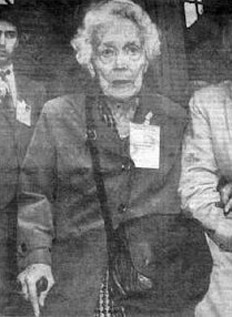
[Above: Lise Lesevre]
“During her last interrogation, Barbie ordered her to lie flat on a chair and struck
her on the back with a spiked ball attached to a chain. It broke a vertebrae,
and she suffered the rest of her life.
‘He told me, 'I admire you, but in the end everybody talks.' But she never did, and
she heard Barbie say finally, ‘Liquidate her. I don't want to see her anymore.’
She was condemned to death by a German military tribunal for ‘terrorism’ but
was placed in the wrong cell and deported to Ravensbruck [sic]
concentration camp, where she survived the war. Her husband and son did not.
She said they were both deported to their deaths by Barbie.
Lesevre said she identified Barbie in February in a face-to-face confrontation at
St. Joseph Prison, where he is being held.”
(See “Klaus Barbie: women testify of torture at his hands,” March 23, 1987, The Philadelphia Inquirer, http://www.writing.upenn.edu/~afilreis/Holocaust/barbie.html)
Needless to say no one corroborated her account, but we historians aren’t supposed to question anything that’s anti-Nazi, you see. Such would be tantamount to genocide. The thought of even questioning anti-fascist claims means one is guilty of a crime. In fact, historians who do so are treated like war criminals. It’s insane.
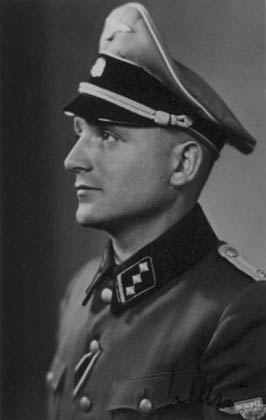
[Above: Klaus Barbie]
There are many hidden histories and truths involving WWII... what would you say are some of the most interesting?
Oh wow, well, there are so many it is difficult to just point to a few, but among the most interesting are the hidden truths involving the immense Soviet and Slavic collaboration before and during the war as well as the hidden truths about Stalin’s planned offensive against Europe. Also, the clandestine Rudolf Hess flight is among the top mysteries of the war. Louis Kilzer is one of few historians who have asked whether Hess was deceived by the British as part of a Churchillian grand scheme. His book Churchill’s Deception makes a compelling case for this thesis and I encourage all readers of my books to read everything written by Kilzer. He asks tough questions and digs deeper than most historians to uncover some interesting facts, statements and memoirs. One in particular is the memoir of Birger Dahlerus, a Swedish engineer, which details the Germans’ efforts to secure some sort of neutrality or alliance with both Poland and Britain. Hitler was apparently ready and willing to back off from his Polish demands and even permit the existence of a “rump Polish state” if Poland would back off from an alliance with Britain against Germany. These back and forth negotiations involving Mr Dahlerus and Hermann Göring went on for some time before the outbreak of war with Poland, but which most historians assert was foregone. Dahlerus’s memoirs, which he asserts remained unaltered from the time they were actually recorded in August 1939, suggest otherwise. Hitler had not decided on a Polish invasion as of yet but instead of accepting this along with validating information, such as that presented by Constantine Pleshakov in Stalin’s Folly and Louis Kilzer in Churchill’s Deception, historians claim Dahlerus was lying or naïve about those oh so evil diabolical ‘Nazi’ warmongers.
Since I have now mentioned Stalin’s Folly, let’s probe the Pleshakov thesis for a moment. Pleshakov asserts that the only primary evidence missing from the ‘indictment of Stalin’ thesis is the document signed by Stalin to proceed with preparations for offensive war against the Reich. Pleshakov insists the signed document exists because other primary sources – the Soviet generals and officials involved in this plan for instance – confirm it. Pleshakov’s case is so compelling as to be unquestionable in my view, so I encourage readers to read Stalin’s Folly. The Dahlerus memoir is extremely rare in German and English so it is likely not a book that English readers will be able to afford, let alone find. I own the English edition and I do plan to incorporate its contents in my upcoming book Albion & Zion United, Volume II, so interested readers will finally know its hidden contents.
Basically, Pleshakov argues that Stalin was preempted by Hitler. Stalin planned to invade Europe in 1942, but Hitler’s own preemptive plans caught the beast off guard. And he was a beast – this book makes it all too clear. He killed everybody he did and didn’t trust and even had several of his best generals tortured in his gulags. One had his eye torn out of its socket and shoved into his hand by his tormentors. Anyway, Stalin was pressured to speed up his plans after Rudolf’s Hess’s flight to Scotland, i.e. the plan to get in touch with the nonexistent “British Peace Party.” Well, as Hitler saw more and more of Stalin’s Red Army troops amassing on Russia’s western borders he – and General Halder – became increasingly alarmed. So then Hitler sped up his own plans, and, well, you can see how it spiraled from there. The interesting thing is that both Hitler and Stalin were manipulated by the British into fighting one another. In the end Germany and Russia were the losers and America and Britain (the Pan-Angles), as always, were the winners.
So, yes, ‘they’ lied to us about World War II and Hitler’s “guilt.”
And since we’re on the topic of the Soviets and Slavs, I might as well delve into their extensive collaboration with the NS government. First off, a number of anti-Soviet Ukrainians collaborated with German intelligence long before the invasion of Poland. This alliance, if I may use this term, formed in 1938. Many of the Ukrainians involved in this collaboration went on to join the elusive Nightingale Battalion, a battle group that not many English readers are aware of. Breaker McCoy of quikmaneuvers.com wrote an eBook that explores this German-Ukrainian effort along with many other collaborative efforts. For example, he wrote two other eBooks, one of which explores Russo-German military and industrial collaboration and secret sharing before Hitler came to power (Secret Wehrmacht in Russia) and another that reveals Russian soldiers switching sides and assisting Paulus against their Soviet overlords at Stalingrad (Stalingrad Campaign), something hitherto unheard of even to me. We read the following excerpt on Breaker McCoy’s website in regards to General Paulus at Stalingrad (How General Paulus Lost the War):
"For the first time since World War Two, a book is available that
provides a professional military analysis of why the Germans were
defeated at Stalingrad. Heretofore the Battle of Stalingrad has been
depicted as a stupid battle where Hitler’s interference and
stupidity caused the destruction of the huge 6th Army. That mindless
mantra has been repeated endlessly as the explanation of what
happened during the World War Two Battle of Stalingrad. Books written
on the subject then recount the same details over and over, tossing
in vivid descriptions of the unfortunate Germans and ‘heroic’
communist snipers."
“The real story behind the Battle of Stalingrad has been entirely
missed by every American and British author of the past sixty years."
“….Finally the Battle of Stalingrad is correctly explained. The
culpability of General Paulus and General Sedylitz [sic], two closet
German traitors, is precisely defined. The deficiencies of German
command along with specific acts of sabotage are clearly explained
and substantiated. Secrets of Stalingrad reveals how General Paulus
lost the Battle of Stalingrad and World War Two for Germany.”
¹Walther Kurt von Seydlitz-Kurzbach (22 August 1888 – 28 April 1976). Per Wikipedia, “He was relieved of his command in early 1943 and then fled German army lines under German fire to personally surrender to the Soviet Union. He became a Soviet collaborator while a prisoner of war. After the war he was convicted by the Soviet Union of War Crimes. In 1996, he was posthumously pardoned by Russia.” We should question whether a general committed to Germany and its government and war effort would voluntarily flee to the enemy side under friendly fire, willingly collaborate with that enemy, and then receive a pardon after committing “war crimes” against that enemy. McCoy’s suspicions about Seydlitz’s loyalty are validated by these facts. Though, we must also fault Hitler for not seeing a problem with Paulus and Seydlitz prior to Stalingrad.
(http://quikmaneuvers.com/secrets_of_stalingrad.html)
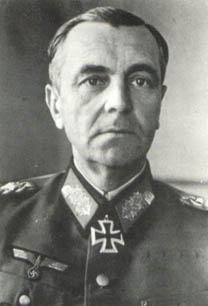
[Above: General Friedrich Paulus]
Perhaps more stunning is the revelation from Dr. Kenneth Alibek in Biohazard (1999) that the Soviets used tularemia at Stalingrad, killing “thousands of German soldiers” and further causing a “generalized epidemic that also affected Russian soldiers and civilians.” (McCoy, Stalingrad Campaign, p. 26) If accurate, this helps explain the Soviet victory as well as the tremendous losses on both sides in that battle. Furthermore, in 1942, an estimated 19,000 Russian soldiers were murdered by their own commanders for insufficient bravado during that battle. Lest we forget, too, that Soviet soldiers’ families were murdered and/or tortured by the Stalin regime if they did not display sufficient enthusiasm against the ‘fascist beast’ in battle. This applied to Stalingrad as much as any other battle of World War II.
Wallace Carol claimed that half a million Soviet volunteers fought with or assisted the Germans throughout the Stalingrad debacle, though this figure may be inflated. At least three German infantry divisions were 50% Slavic during the battle: the 71st, 76th and 79th. On paper, however, the German 79th was “pure Aryan” and one in every five soldiers in this division was a card carrying member of the NSDAP. As for the German 376th, that division counted one hiwi (volunteer helper) for every two Germans. Literally tens of thousands of Soviet volunteer units fought on the Stalingrad frontline for Germany. It is facts like these that rouse consternation amongst historians like me when we encounter German chauvinism and supremacy from certain revisionist researchers online, such as those with their innumerable German worshippers who bash and trash Slavdom relentlessly. Without Slavic assistance Germany would have lost the war sooner and perhaps even suffered worse atrocities (such as rape) and losses. These Germanists should read more about these Slavic ‘Nazis’ to learn that the German 94th and 295th consisted of Russian combat and service battalions made up of volunteers. Many of these volunteers defected to the German side during the battle for Stalingrad! As McCoy concludes, “Without thousands of former Soviet volunteers fighting on the frontlines, the Germans could not have held out as long as they did.” (Stalingrad, p. 185) The Germans did not have the manpower without this sizable Slavic presence. And to those modern German supremacists who claim that the Slavs were incompetent soldiers, Dave Parham offered the following: “…Soviets showed great skill in house-to-house combat” and “…Russian volunteers performed splendidly as riflemen and machine gunners.” (Ibid.)
So many Soviet deserters flocked to the German lines during Stalingrad that the Germans were able to staff a full division (12,000 men). “Thus thousands of former Red Army soldiers were organized and armed, inside Stalingrad, by the 6th Army.” They utilized captured Soviet weapons and were bolstered by the German 9th Flak Division. This virtually unknown Slavic Axis contribution, the Von Stumpfeld Division, defended the Tractor Factory sector of Stalingrad and fought until they were literally wiped out in the first week of February 1943. This division consisted of the following elements:
Schmid Infantry Regiment
Kamenberg Battalion
Lindner Battalion
Eisenacker Battalion
Kortherr Battalion
Engert battalion
Von Caddnebruck Battalion
Kharkov II Battalion
Morossowskaja Cossack Battalion
A Flak Detachment
Abendrot Tank Company
An Artillery Group
The great divide between what is taught in the schools of Western civilization about WWII and the actual facts is disturbing. Would you say that in today's information-driven society people are searching out the truth more on their own than in the past?
I cannot say with certainty that people are searching more than they used to, but what I think we can all agree on is that people interested in digging beneath any topic have more accessibility than they ever had before. Even libraries offer free Internet access. Before the Internet revolution people were limited to books and oral information. Today most people are just a click away from accessing millions of relevant books, articles, primary documents, photos, newspapers, etc.
That said we must remember that Paul Rassinier, the unofficial “father of holocaust revisionism” started publicly questioning the accepted World War II narrative in the late 1940s and wrote about his disputations in The Lie of Ulysses (1950). Thus the information has always been there for anyone to access. The Internet has just made it much easier.
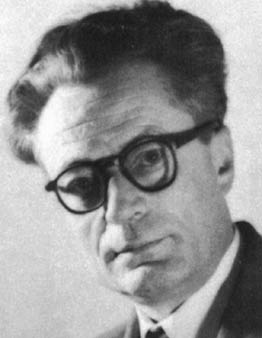
[Above: Paul Rassinier]
The internet is a two-edged sword, while it offers uncensored information, it's still cluttered with idiots and system propaganda. Is there anywhere you can recommend as a good source of unbiased information regarding WWII?
Unfortunately I have not come across any single website or online source that is wholly reliable. The problem with most revisionist sites is that they present an exaggerated positive view of NS and Adolf Hitler. They dissuade or deny any critical or negative assessments of the Germans and/or Axis and this is as problematic as the mainstream websites and sources.
Our goal needs to be honesty and balance not dogmatism and idol worship. Both the Allies and Axis committed crimes and both sides made military mistakes, so we should acknowledge this.
Of all the aspects of WWII, which are seemingly unlimited, what is your favorite to research? What facet has proven to be the hardest for you to research thus far?
There’s no doubt that my main interest is the nonwhites and foreigners who assisted the Axis for a variety of reasons. It has proven to be a fascinating topic that I enjoy studying because it is so taboo. ‘White nationalists’, court historians and Jewish supremacists alike attack this area of research because it challenges their respective narratives and preconceived notions. Jewish historians attacked Bryan Mark Rigg, a Jewish historian himself, for writing about “Hitler’s Jewish soldiers.” At least one of his dissertation advisors told him he would find nothing about Jews in Hitler’s service and reprimanded him for choosing such a silly topic. Rigg’s extensive research and findings suggest otherwise. He estimated that up to 150,000 Jewish men served in the German armed forces and/or Navy. And this area of World War II research is growing by the day as a recent article entitled “The Jews who fought for Hitler: ‘We did not help the Germans. We had a common enemy’” proves.
Paul Kendall of The Telegraph wrote on 9 March 2014:
“With little regard for his own safety, and in the face of heavy Soviet shelling,
Major Leo Skurnik, a district doctor who had once fostered ambitions of
becoming a concert pianist, organised the evacuation of a field hospital on
the Finnish-Russian border, saving the lives of more than 600 men, including
members of the SS.
Skurnik was far from the only soldier to be awarded the Iron Cross during the
Second World War. More than four million people received the decoration.
But there was one fact about him that makes the recommendation
remarkable: he was Jewish. And Skurnik was not the only Jew fighting on the
side of the Germans. More than 300 found themselves in league with the
Nazis when Finland, who had a mutual enemy in the Soviet Union, joined
the war in June 1941.
The alliance between Hitler and the race he vowed to annihilate — the only
instance of Jews fighting for Germany’s allies — is one of the most extraordinary
aspects of the Second World War, and yet hardly anyone, including many
Finns, know anything about it.
“I lived here for 25 years before I heard about it, and I’m Jewish,” says John
Simon, a New Yorker who moved to Helsinki in 1982. “It’s not a story that’s told
very much.”
(See http://www.telegraph.co.uk/culture/museums/10682975/The-Jews-who-fought-for-Hitler-We-did-not-help-the-Germans.-We-had-a-common-enemy.html)
Being as your books aren't the usual biased and tired old system propaganda, have you found it difficult to find publishers or printers? I imagine there are a legion of idiots who hate to hear anything different than what they were programmed.
I have never tried to publish with an established publisher. Indeed I have always doubted whether any publisher would touch my books. I have even encountered problems with revisionist publishers such as Inconvenient History. For some reason they refused to publish several submissions I sent them when they asked me whether I had any material I would like them to post on inconvenienthistory.com. I was not given an answer as to what the problems were with my submissions and I have since decided against allowing them to publish any material of mine.
I decided from the get-go to form my own publishing company, a home-based business. I mastered the graphics and printing programs on my own. I originally contracted with Necro Publications and Fat Cat Graphic Design to create my book covers and text files. I started doing all of the work myself to speed up and improve the editing and publication process, though I have nothing but positive things to say about Mr Barnett’s publishing and graphics company. He did excellent work for me and I still recommend him to anyone publishing for the first time. And he’s not afraid to assist with taboo material.
On the subject, famed British historian David Irving has gone through a minefield of legal entanglements and even prison time for merely discussing ‘unfashionable' facts regarding WWII. As you know, in Germany and many parts of Europe a person can be jailed for years for literally just questioning ‘established history'. What are your thoughts on all of this lunacy and have you ever done speaking tours? Would you ever go to Europe knowing the oppressive laws regarding freedom of speech?
I am appalled at the hypocrisy of the liberal democracies when it comes to free speech. Liberals and proponents of democracy claim to uphold free speech and free thought in order to oppose fascist thought control and authoritarian rigidity, but they are hypocrites and liars. The truth is that the Western world is living under liberal fascism – I prefer the term authoritarianism or even tyranny – which seeks to stifle or outlaw any idea or movement that threatens its power-hold.
Furthermore, liberal historians screech about how the ‘Nazis’ were intolerant of liberalism and any ideas that threatened the NS worldview, but how are these liberals any different from the ‘Nazis’ they screech against? Are they not also controlling thoughts and ideas that threaten their worldview? The old biblical saying about removing the plank from one’s own eye before pointing out the splinters in the eyes of others could not be more applicable here.
In the light of this liberal fascism that threatens us all, I will not visit Europe, no. As many problems as America has today it is still more free than Europe. Until Europe discards its archaic anti-free speech laws I will not set foot there. If I want to experience the Middle Ages I will go to Excalibur in Las Vegas. I have no interest in being a liberal powerslave.
On a final note I think it’s important to reiterate that the National Socialist system was not a free speech or free thought system. But then, what system is?
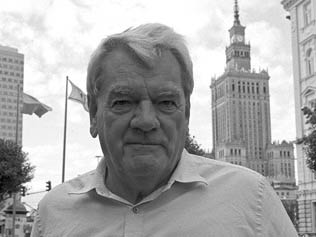
[Above: David Irving]
Speaking of oppression, have you heard of Greece's Golden Dawn and the imprisonment of their leader? It seems more and more people are being imprisoned or killed for having questions or different opinions that challenge the powers-that-be. Your thoughts? Can you envision the day that certain history books are officially banned in the United States?
I have heard of Golden Dawn and yes, I am aware of the imprisonment, murder and oppression of several of their members and leaders. This is yet another example of liberal fascism at work: for if liberals and upholders of democracy really believed in what they claim to believe in – free speech, free thought, freedom of association and tolerance – then they would not be oppressing, murdering and arresting members of Golden Dawn. This is not how democracies and liberals are supposed to operate. Nay, this is allegedly how fascists operate (or so we’re told).
History teaches us that before there are any retractions of oppressive laws or tyranny there must first be suffering and death. This has always been the case so there’s no reason why the modern age will be any different.
As for books being banned in America, we are already seeing this happen. While unorthodox and revisionist books are not being outright banned or burned in pyres, both book sellers and publishers are being threatened, attacked, and/or ostracized for putting out anything that the Albionist-Zionist authorities deem “Nazi apologism”, “pro-fascist”, “anti-Semitic”, or “holocaust denial”. My books have been targeted by Calvin College’s Randall Bytwerk as well as by Assistant Professor Ethan B Katz at the University of Cincinnati. Both have tried to send certain of my books “into the Amazon cellar” (Bytwerk’s verbatim words) or to dissuade Amazon customers from purchasing them. I know for a fact that lulu.com bans sellers of revisionist titles if they are reported to Lulu. This is why I refuse to sell my books on Lulu. Credit must be given to Amazon CEO Jeff Bezos, himself Jewish, who has not buckled to Jewzi lobbyist demands to ban unorthodox World War II titles on Amazon. In this respect Mr Bezos is an upholder of liberal-democratic values.

[Above: Nikolaos Michaloliakos, leader of Greece's third largest political party the Golden Dawn.]
Hermann Goering mentioned in an interview after surrendering to the Allies that he was confident that if the war had lasted a few more months that it might have had a different outcome, being as many of Germany’s factories had been moved underground and out of reach of the Allied bombs. What is your opinion, with Germany’s ‘wonder-weapons’ coming into play, would it still have been too late?
These “what if” questions are impossible to answer with any degree of certainty, though I will offer my thoughts given what I know about Germany’s ‘last days’ circumstances. Thus we will encounter a lot of speculation in my answer.
The V3 “super cannon”, which was never used against Britain, was supposed to prevent the final collapse of Germany. This was likely the weapon to which Heinrich Himmler referred when speaking with Gunter D’Alquen about Andrei Vlasov. Hitler, like Himmler, allegedly pinned his hopes on the V3 to such an extent that the Russian campaign suffered as a result. This is possible given that he and Germany were about to lose everything they had worked (by this time) nearly 20 years to achieve. But this false hope would not last.
The RAF was also able to locate and attack the V3 installation at Pay de Calais in 1943. The project was finally officially terminated in February 1945, but not before Albert Speer invested a tremendous amount of human and monetary capital into this unscientific project which General Erich Schneider, Professor Werner Osenberg and the renowned Anton Huber all knew was unrealistic. The shells used in the testing of the V3 were too small to affect London as intended; as well, the shells flipped in midair owing to lack of stability. Schneider knew that only an atomic warhead could accomplish the desired annihilation of the City of London. Per his account, Hitler refused to listen, though by that time it was too late for German atomic development anyway. That said, according to Henry Stevens and his sources, the Germans had the bomb – some have suggested that “Little Boy” was Germany’s bomb – but they lacked an adequate delivery system. This may have been the motive for conceiving the Silverbird but this is pure speculation.
Wrapping up on the V3, despite the super cannon’s ‘High Pressure Pump’ issues as well as its velocity limitations of only 1000 meters/second, 44 rounds were fired in the Battle of the Bulge. The V3’s last shells fell on Luxembourg and the barrel was destroyed.
Now, the V-1 and V-2 rocket bombs, as you know, were used heavily against Britain. But neither of these weapons proved decisive for Germany’s war effort. They were inaccurate and oftentimes hit uninhabited or unimportant targets. The Germans would have been better off had they invested in aerial bombers from the get-go and carpet bombed Britain and Soviet installations day and night. This is one of the key areas where Hitler and his grand strategists failed. They used this method against Poland but relied too heavily on land assault in Russia. As for Britain, the Germans brushed them off as “as good as defeated” post-Dunkirk and that nonchalant arrogance cost them the war. Britain came back to wreak havoc with a vengeance hitherto unwitnessed in modern warfare: the relentless carpet bombing of German cities, transportation networks and military-industrial installations that were all vital to Hitler’s war machine.
No, the wonder weapons, as fascinating and progressive as they were, could not have turned the tide. What could have turned the tide was more manpower and greater industrial output. Germany couldn’t keep up with Anglo-Saxon mass production nor could they hold off the waves of humanity being hurled at them in the eastern sectors. Whether atom bombs could have changed this is debatable, as just a few of those could have annihilated British and Soviet targets and with that their war morale. But could Germany have delivered the bombs deep enough into British or Soviet territory late in the war? – Doubtful. They did not have enough highly skilled and adequately trained pilots at that time. They also didn’t have enough bombers, let alone a bomber that could bear the burden of the weight and altitude necessary to deliver said bombs. Not even the ME-262s could be redesigned as bombers in time for Hitler’s Western defenses thanks to Messerschmidt’s lollygagging and false promises for the sake of a government contract. Hitler was furious, but rage doesn’t save the day.
Germany should have utilized the eastern manpower that surrendered (as well as volunteered) so readily after Stalin’s initial collapse. Germany was at her peak of power and prestige and the easterners had their most positive and hopeful view of the Germans at that time. But, alas, the Germans blew it. Too arrogant and too committed to their initial racism to see that opportunity for what it was. The Germans lacked both insight and foresight at the highest levels of command. And it was not just the ‘Nazis’ who blew it: many a Wehrmacht commander and bureaucrat did as much or more damage than committed ‘Nazis’ did in this regard. The key here is that Germans blew this opportunity. Secondly, the Germans were not murderous enough in their thinking. They needed to think more like Roosevelt, Stalin and Churchill: scorched earth, carpet bombing 24-7 and gulag enslavement. This may seem crazy or silly to some readers, but I have long argued that Hitler and Germany were not tough enough to wage war. One must be a real monster to win.
While these errors are easily spotted in retrospect, we may still fault the German authorities, especially the political and propaganda authorities, for failing to recruit and accept more non-German and ethnic minority assistance early on. While it is a fact that Slavs, Indians, Arabs and many other non-Germans were not entirely reliable in battle, they nevertheless ought to have been recruited and trained much sooner and in much greater numbers than they were. This tremendous amount of manpower and the political perks that would have come along with such recruitment would have bolstered Germany’s standing militarily (numbers wise) and image wise (appearances are everything). The so-called ‘Third World’ peoples would have seen Germans as non-racist and perhaps even as saviors of the world against the Anglo-Saxon/Zionist/Communist menace. This was not something to throw away as lightly as the ‘Nazis’ did.
The last thing I will say is that the Germans should have been quicker to develop atomic weaponry and the means to deliver such weaponry. In our modern industrial-machine age, nations and peoples must be ruthless in their means or they will, like the Germans, lose. On a final note, readers may want to check out R J Overy’s Why the Allies Won, as it appears highly recommended.
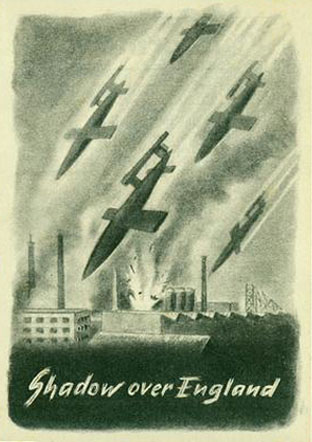
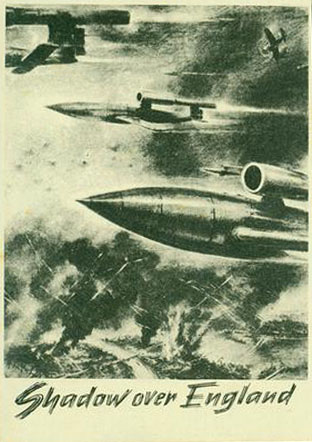
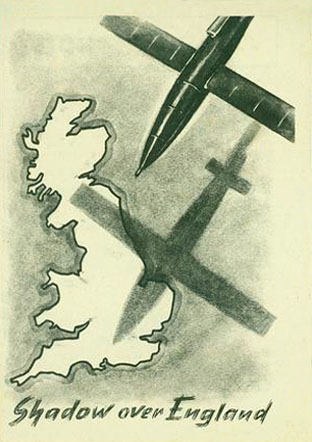
[Above: German V1 leaflets dropped on Allied armies.]
The list of National Socialist Germany's technological achievements is mind-boggling. From jet airplanes, helicopters, guided missiles, ejection seats, synthetic rubber, the submarine snorkel, the assault rifle, stealth technology, lasers, night vision, atomic research... the list goes on and on. There are numerous speculations for this technological prowess, but I believe that the Germans had a renaissance. Not only a social one, but an artistic and scientific one and in many other facets of their culture as well. They were a united people, full of pride, and had an optimistic spirit. What are your thoughts?
I agree that NS Germany stoked a renaissance spirit not just in Germany, but in Europe and even elsewhere. The Americans, Soviets and British all experienced their own respective reactionary ‘renaissances’ as a result of that touched off by Hitler’s movement. Really, when one sits back and looks at everything that happened in the ‘Developed World’ as a result of Hitler’s rise to power and decision to invade Poland, one is astounded at just how much martial, political, social, financial and even global relational change took place. The Second World War was a sort of renaissance and revolution in itself. It was an irreversible and perhaps unavoidable process that the Western world had to endure for ends that we are still obviously trying to decipher.
Thus it is not without some legitimacy that many thinkers and even Hitler admirers today blame Hitler and the ‘Nazis’ for inducing guilt for both real and imagined evils. For example, Greg Johnson writes in this regard:
“…Every April 20th, White Nationalist websites inevitably see an increase in
discussion and debate about Hitler and his legacy. Positions usually array
themselves between two poles: Hitler is the problem and Hitler is the solution.
The claim that Hitler is the problem is basically a rejection of an intolerable
burden of guilt by association. Hitler is the most hated man in our whole
Judaized culture. Indeed, hating Hitler is the only moral judgment not
stigmatized by modern moral relativists. The only absolute moral standard we
are allowed is Hitler as the incarnation of evil, and all lesser evils are evil by
being ‘like Hitler’ — which ultimately means that all white people are evil due to
our kinship to Hitler.
The ‘blame Hitler’ argument boils down to this: If only Adolf Hitler had not
started World War II, killed six million Jews, and tried to conquer the world,
White Nationalism would get good press and perhaps make some progress in
the political realm. Hitler is the reason why race realism, eugenics, immigration
control, and nationalism have been discredited in the eyes of whites the world
over. Thus if White Nationalism is to have any chance of changing the world, we
need to ritually condemn and repudiate Hitler and everything he stood for, as
well as all his present day followers.
I find this argument to be morally contemptible and politically naïve.
It is contemptible, because it is essentially an attempt to curry favor with our
enemies and pander to ignoramuses and fools by throwing a loyal white man
under the bus. And make no mistake: Adolf Hitler, whatever his faults, was a
loyal white man who fought and died not just for Germany, but for our race as a
whole."
(See http://www.counter-currents.com/2011/04/the-burden-of-hitler/)
While I am no white nationalist, I agree with Mr Johnson’s premise as to why Hitler is a problem for all, or nearly all, European descended peoples today (I’ll use “whites” for simplicity’s sake). However, I believe this only applies to “whites” who either refuse to, or cannot, critically think. Indeed this bizarre liberal-democratic interpretation and application of the meaning of Hitler is the real problem and burden. First of all, I have not met a single non-white/non-European person who exhibits the same fanatical reactionary attitude towards Hitler as the typical “white” conservative or liberal man on the street. Furthermore the extremely liberal “whites” and even many Jews I have known and spoken with are open to hearing alternative views of Hitler and even “the holocaust.” This raises problems in our understanding of what it is that causes the fanatical, emotional and asinine reaction average “whites” and liberals exhibit when the terms “Hitler” and “good” are mentioned in the same context. Are these people deliberately ignoring what they know may well have validity for the sake of perception management? In other words, are they gatekeepers of some kind? Or are these people really so mentally dense and overly emotional that they just cannot hear anything that challenges their rigid worldview? I’m not sure, but these people, not Hitler being a part of Western culture, are the problem and burden. You see, non-whites do not act like this. If you and I were to inform an average Chinese person about China’s ‘holocaust’ of the Zunghar Mongols, that Chinese person would stare at us and reply, “And”? And if you and I were to try and convince an average Indian man that he is guilty by association for the “holocaust of Jews” because Subhas Chandra Bose and several thousand Indians supported Hitler, he would probably laugh in our faces. Yes, I am generalizing from several personal experiences I have had since taking on the Hitler taboo, but I am confident that a scholarly study into this matter would support my experiences. So, let us move beyond this fanatical liberal idiocy and finish answering your question.
The NS revolution was something for all Germans to be proud of, not ashamed of. Hitler and his system allowed science and technology almost free reign to develop and/or influence cutting edge technologies in numerous sectors, from industry to personal health. Not only that many of Hitler’s social policies, including those pertaining to women, were progressive. The ‘Nazi’ system was the first to advise women to conduct breast self-exams to detect cancer masses early. The ‘Nazis’ were also the first to publicize the causal link between cigarette smoking and lung cancer. The government propagandized against smoking. And while the government propagandized against the image of the “liberated” industrial or career woman, Hitler’s actions as well as those of many social institutions in Germany flouted this image. Hitler’s war did more to “liberate” German women from being Weimar maids, housekeepers, domestic help-hands and mothers than any other decision he made. Even Afro-German women benefited from the war.
As far as class and status under the ‘Nazis’, David Schoenbaum offers the most comprehensive objective study. He explores everything from Himmler’s feudalistic fascination with the peasant and land (“peasant principle”) and how that affected farm and settlement policies to how free ‘Nazi’ economic policy was from dogma or principle. Businessmen big and small did well and big businessmen were taxed less by the socialist ‘Nazis’ than by the capitalist ‘Federal Republic’ after the war (i.e., 38.2% vs. 44% in 1966). Another example of social reform Schoenbaum provides is that nearly 30% of big industry’s domestic expenditure went to worker housing. Can anyone in America today imagine big industry paying to house its employees? It’s unimaginable. Most Americans would in fact scream “communism” if they heard such a proposal from their government.
Another crucial revelation Schoenbaum explores is the disintegration of the demarcation line between society and the state. In the ‘Nazi’ mind the two were synonymous, so private ventures ceased to exist whether they were personal or business related. Even private property only remained “private” when it was developed or used “correctly.” Again, this made NS similar to communism though no gulag camps or terror regime was necessary to get the German people’s compliance. The overwhelming majority of Germans loved Hitler, tolerated or liked NS politics and benefited from the new system in some way. They had little or no reason to resist. And the key to Hitler’s popularity and success is that he offered something to everyone. No group was left out, not even Jews. Jews were permitted to conduct their own affairs amongst their own so long as they did not run afoul of the state. This only changed after Crystal Night (1938).
Moving along here, corporate taxes increased significantly under Hitler. Most of us feel positively about a reform like this. Interestingly, mortgage rates were reduced in 1935 and housing, unlike other industries, was largely a private affair. In NS Germany public spending ruled the roost. While Germany spent 35% of its national income on public works, France spent some 30%, the UK just 23.8%, and the US spent a mere 10.7%. Which one of these four government systems was ‘of the people, by the people and for the people’ again?
Though they didn’t like it, the ‘Nazis’ also supported department stores. Consumer co-ops were permitted to carry on if they were “more capable of meeting available demand than private retail trade.” Even Jewish department store chains, like the Hertie chain, were allotted millions of public marks (RM 14.5 million to be exact) for the sake of employment.
And then there was the KdF with its variety of worker perks and labor reforms. These included motor vehicles that laymen could afford, symphony visits to various machine plants (the modern equivalent of which would be having a rock concert at your workplace), subsidized theater shows and concerts, exhibitions, films, adult education courses, sport and hiking events, dances, tourism, holiday vacations, as well as limited work hours, days off, safe working conditions and even honor systems that permitted workers to inspect their own work and establish their own piece-work rate. In typical NS fashion, working conditions were improved at employers’ (not taxpayers’) expense. These improvements included improved lighting, kindergartens, housing, athletic fields, parks, locker and shower rooms, canteens with reduced-cost hot meals, and competitions featuring various prizes to the winners. Though the 8-hour day was the most common in NS Germany, a 10-hour work day was recognized as the “official limit” and overtime pay was set at 125% of the normal hourly wage. These things were rare or unheard of until the ‘Nazis’ pioneered the way. America and Britain copied, as usual, to try and keep up. Germans were experiencing an undisputed rise in their standard of living and a hitherto unmatched upward mobility.
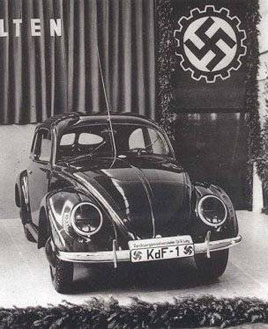
[Above: The Volkswagon, or People's Car.]

[Above: Workers volkswagon stamp to be put in a saving book to eventually buy a car!]
Another intriguing aspect of the NS revolution was its tolerance of tradition in various sectors. Take the Foreign Office for example. It remained intact and untouched by Hitler. Schoenbaum relates, “Not a single Nazi became chief of a foreign mission.” That in itself was revolutionary: Hitler left some things alone! -- Universities and professors, for example. Furthermore, and contrary to postwar mythology, the Army never protested any of Hitler’s moves. In fact it was General Blomberg who guaranteed Hitler there would be no martial law as long as Hitler assured the military its place in the sun in the new Reich. They met in secret aboard a ship, though no minutes of this meeting have ever been found. We only know of this top secret deal via circumstantial evidence. At any rate, blackmail was used against Hindenburg and we need only guess who provided Hitler with Hindenburg’s dirty laundry – Blomberg of course! Hindenburg appointed Hitler to ‘save face’ as well as his corrupt son Oskar’s reputation before the fed up masses.
Since we’re on the subject of Hindenburg, I’d like to discuss the book Hitler's Beneficiaries for a moment. It's about those who benefited from the NS revolution.
While the book is anti-Hitler, the ignorant author can't help but notice the innumerable positive benefits of Hitler's election. And that's another thing—the man was elected. Everyone seems to think that he bashed his way through the door, but in fact he was cheated out of the chancellorship that he rightfully deserved at least twice before. His party was the Reichstag majority. He deserved the chancellorship. After he finally got it, and with hardly a foot in the door, that old elite clique of industrialists and propertied Junkers around Franz von Papen tried to boot him right back out the door. One wonders what drove him to keep pursuing power after all that intriguing and blackmail against him. He must have had something extra in his being – something typical people don’t have. Court historians call it “evil” and “megalomania.”
Of course, few of these “historians” dare to mention that Hitler was appointed only after he had been forced to blackmail Hindenburg in turn. Hitler got wind that Hindenburg was given a large Junker estate in East Prussia. While not illegal, when the deed to the estate was made known, it contained the name of Paul von Hindenburg’s son, Oskar von Hindenburg, as owner – instead of the old man. This was an attempt to avoid the inheritance or death taxes that would come due upon the death of the 85-year-old retired general. And so it was that Paul von Hindenburg became “responsible” for appointing Hitler, the man who had achieved 34% of the vote in the November 1932 elections – a larger percentage than anyone else besides Hindenburg himself. In fact, Hitler would have been elected president of the German republic if Hindenburg hadn’t clung on like crusty old butter on bread. Up until the old man’s death, in August 1934, he had prevented Hitler’s appointment. He refused to appoint Hitler until he was blackmailed, and further assuaged by a gift of 450,000 marks for which he failed to pay taxes on, plus an additional 5,000 acres the NSDAP was compelled to add to his estate after January 1933. Talk about a corrupt old order! The NSDAP and Hitler were the majority in the state, and Hitler had the largest popular following but they still had to buy their way into power. It’s all too familiar. That’s how all democracies operate. And America’s the worst of all. In addition, the old man still had the clout to protect the life of a personal friend, Franz von Papen – himself a previous failed chancellor – which he did.
Yes, Hitler really was a remarkable human being. And as one of his oldest secretaries recently noted, he was a very generous, caring, unselfish person who took an interest in the comforts and lives of those around him. Such a huge man, perhaps the most powerful in the world at the time – certainly the most loved leader – cared about the lives of the so-called ‘minions’. And he did not live lavishly or demand much either. He even traveled without security and in an open car most of his life. Nonetheless we’re all expected to believe he was a genocidal megalomaniac and psychopath, a man who simply used Germany to realize his own grotesque delusions of grandeur and war gaming. Obviously too few people know the truth about Stalin, FDR and Churchill – that loathsome Brizi warmonger who deserves to have his name blotted from the history books for all time. And since when do psychopaths care about anyone or anything around them? They offer no genuine caring and they certainly aren’t statesmen in the likeness of Hitler. No, they’re more like Stalin. Hitler did everything he did for the commoners, the caste to which he himself belonged. He emerged from among us, the masses – was elected – and then pulled off one of the greatest economic miracles in human history.
While America was still languishing with a 19.8% unemployment rate in 1938, Germany's was just 2.1%. And the rearmament program had only begun in 1936 with the advent of Göring's Four Year Plan. I came across this in books by Burton H Klein and Richard Overy, among others. While respectable Jewish historians, like Dan Silverman, have tried to obfuscate Hitler's economic miracle, they have not been able to get around the fact that something incredible happened in Germany which did not happen anywhere else. Even Japan – with their vast rearmament efforts, wide range of skills and incredible work ethic – had a 3% unemployment rate. And it isn't as though the United States had not rearmed by 1938 or did not have a vast military expenditure program of its own! And Britain too! – Yet, Britain's unemployment rate was 12.6% in 1938. No one can possibly say that Chamberlain and Churchill had no military budget. That would be outrageous and authors like Silverman must know this.
Moving on, to appease the military Hitler made the Waffen SS subordinate to the Army in case of war. Even in 1938/39, the War Ministry refused to accept mandatory ‘Nazi Party’ membership of all civil service applicants. Equally striking is that the Hitler salute was never introduced in the new Air Force and it was even cancelled owing to Wehrmacht pressure. Contrary to fable, Hitler did not suggest or require this salute: it was introduced by Frick as a decree in 1935 to demonstrate the solidarity shared by the Wehrmacht, SA and SS.
One of the more interesting consequences of the NS revolution is that the Wehrmacht officer corps became the least snobbish in German history. Though many of the “vons” resented the de-aristocrazation of the military, it happened nevertheless.
While elitism was never quashed by the revolution, the SS offered unprecedented social and educational mobility and opportunity and became a civil service in its own right. In Schoenbaum’s view it superseded the state. And we must remember the SS was neither a political party nor the ‘Nazi Party’; it was a technocrat-dominated neo-feudal order that was slowly encroaching upon every aspect of the state. And unlike what we’ve been told about rigid SS selection, manning the SS had everything to do with reality – vanity, opportunism, expediency, morale and social necessity – and next to nothing to do with theory – i.e. exclusion of anyone who was not blond, non-Aryan, Nordic, non-Jewish, etc. The new German nobility ideal was largely chimera.
The NS revolution did not create a new elite and system that imposed itself on the state. Rather, the new NS elite infiltrated and encroached on the pre-Nazi elite. Hitler’s revolution has been called a “reactionary movement” rather than a “revolution” by some. The truth is that NS possessed elements of both. There was no new class or new elite, yet there were fascinating achievements such as the voluntarily capitulation of the Army to civilian administration. NS was oddly dynamic, fluid and adaptable while simultaneously traditional. The old status quo revolted against Hitler and his intended plans with measurable success. Yet despite the triumph of the bureaucracy over the Party and the clinging of the ways and days of old, NS was able to break down class barriers like no system before it or since. It was an enigma, a paradox, a mystery. And it is this about NS that I think stokes people’s interest in it, not that it or its founder were “evil.”
Anyone wishing to look into the taxation system, art, women’s employment, the re-endowment of labor and layman, fiscal reform and a number of other social reforms instituted by the NS government ought to read all of the primary source pamphlets available at third-reich-books.com along with Hitler’s Economy: Nazi Work Creation Programs, 1933-1936 by Dan Silverman, The Nazi Economic Recovery 1932-1938 by R J Overy, Hitler’s Social Revolution: Class and Status in Nazi Germany, 1933-1939 by David Schoenbaum, Race and the Third Reich: Linguistics, Racial Anthropology and Genetics in the Dialectic of Volk by Christopher Hutton, The Nazi War on Cancer by Robert Proctor, and Hitler and the Power of Aesthetics by Frederic Spotts.
Expanding on Germany's remarkable ventures into the scientific frontiers... I've recently read a few books on medicine and the war against cancer during the Third Reich. Here again Germany were pioneers. Germany was the first to discover a myriad of contributors to cancer, primarily tobacco use. Many important scientific papers were published and some are even still referenced today. The levels that the National Socialist government was willing to go to protect their population was staggering. No where else in world had free cancer screening or highly publicized and progressive anti-tobacco campaigns. What are your thoughts on this? Would this be a field you would ever consider writing about?
Oh yes, the NS government was well ahead of its time in too many scientific and health areas to count. I’m not sure I need to write a book about this as Proctor has actually given the world a thorough and surprisingly objective account. I encourage everyone to read his book even though it often relies on Nuremberg fantasies. A nice counter balance to Proctor is Carlos Porter’s Made in Russia: The Holocaust. I recommend reading the two successively.
During the first few months as chancellor Adolf Hitler had the Reichstag enact laws for the protection of animals, and in 1936 he decreed regulations for the humane killing of lobsters and crabs. In 1933 Reichsmarschall Goering declared an end to vivisection, banning it and calling it 'unbearable torture and suffering in animal experiments' and threatened to imprison 'those who still think they can treat animals as inanimate property'. What are your thoughts on this?
I think it was a wonderful idea. This NS ‘animal rights’ movement’ was ahead of its time seeing as how we still grapple with this issue today. On a personal note, I seldom eat meat and I buy organic, cruelty-free, cage-free and ‘non-GMO verified’ whenever I have the opportunity. Preventing animal abuse is important to me. That said, I understand the research side of the issue and here are some of my thoughts about it.
Given the controversial and emotionally charged nature of the animal research debate in the United States, an important question to ask is whether animal research is still necessary given modern day technological advances in scientific and psychological research. Asking and answering such a question may help eliminate personal attacks against animal researchers as well as arson and bomb attacks against animal research facilities. It may also help resolve concerns animal welfare groups continue to voice about treatment and handling of research animals.
While the answer is still “yes,” since no absolute alternatives to animal research are yet available, animal welfare groups may take comfort in the fact that numerous technological advances have been made in the animal research industry which have minimized the numbers and types of animals needed for research. Furthermore, the benefits of animal research, which comprises just 0.3% of approximately 6.3 million animals killed annually in the US, are not limited to human beings: Animals also benefit from animal research and this is something that animal rights groups may support if concessions are made in other areas.
For instance, if researchers and facilities can show that they are reducing the number of animals used for research in favor of computer modeling and other replacement research techniques and procedures, groups like PETA may be more willing to accept limited animal research. While some welfare groups refuse to accept anything but an end to animal research, at least researchers can honestly claim that they are working toward that goal. However researchers and facilities must demonstrate consistent and reliable conduct in this regard; otherwise when groups like PETA secretly film facilities abusing their animals, the debate will end up right back at square one. If a facility assures the public and animal welfare groups that it is obeying animal rights laws and that it is working toward alternative research methods, then said facility ought to be doing just that on a consistent basis.
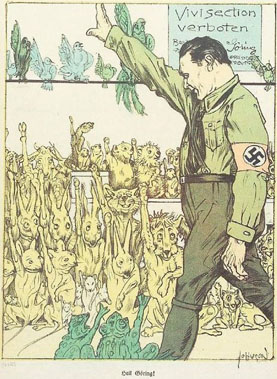
[Above: 'Heil Goering' and 'Vivisection forbidden'.]
I feel that animal research should only be utilized if there are no other alternatives available. The United Kingdom has successfully implemented such a system, which reflects and incorporates the attitudes of the public as well as the scientific community. An EMBO Reports talking point article, authored by the London-based Research Defence Society’s Festing and Wilkinson (2007), concluded that
“…the UK government introduced...an Ethical Review Process at research
institutions—which promote good animal welfare and humane science by
ensuring that the use of animals at the designated establishment is justified. The
aims of this additional review process are: to provide independent ethical
advice, particularly with respect to applications for project licences, and
standards of animal care and welfare; to provide support to licensees
regarding animal welfare and ethical issues; and to promote ethical analysis to
increase awareness of animal welfare issues and to develop initiatives for
the widest possible application of the 3Rs—replacement, reduction and refinement of the use of animals in research.”
The UK’s 3R campaign – replacement, reduction and refinement of the use of animals – has significantly reduced the need for animals in research. The UK scientific community is working toward using fewer and fewer animals, instead utilizing computer modeling, cell and tissue cultures, and other alternative methods of research. Though, these alternative efforts on behalf of the scientific community in the UK were only achieved after animal welfare groups became violent enough to force such changes at the highest levels of government. My hope is that violence and personal attacks against researchers will no longer be necessary to enforce changes on animals’ behalf.
Since human beings have total and absolute power over the lives and welfare of research animals, it is our responsibility to respect those animals and never abuse that power. So long as abuses are discovered (e.g. in 2004, the University of California, San Francisco was accused of 60 violations of the Animal Welfare Act by the US Department of Agriculture), I’m afraid no such respect and responsibility will be earned by researchers and facilities. The animal research community needs to seriously and consistently work on this because anything less is unacceptable, just as anything less for human research subjects is unacceptable.
I've listened to you speaking about the many Russians that volunteered for various service with Germany and how German hatred toward them has been greatly exaggerated. Can you explain more about this? I've also read that most of these volunteers were, rather maliciously, turned over to the Communists after the war, where they were killed or sent to death camps. General Vlasov is a particularly nasty example of this. He was turned over to the Russians even after being given assurances otherwise.
Since I’ve already touched on the Slavs in an earlier answer I will focus mostly on the number of volunteers, the competing schools of thought concerning the Russians as well as the evolution of Himmler’s attitude towards Vlasov as a result of the war turning sour.
First let’s discuss the number of “Russians” (I am using this term a bit loosely here) in German service. While numbers vary depending on which historian we consult, there is widespread consensus that at least one and a half million Russians of varying ethnicities and nationalities fought with the Germans. Slavic-German collaboration had in fact started before any set-piece battles took place. The Abwehr began training Ukrainian anti-communist combat units in 1938. Per Breaker McCoy,
“One of the most famous of those units was the Nightingale Battalion made up
of former West Ukrainian Polish soldiers… In June 1941, a Nightingale
battalion attached to the 1st Battalion of the Brandenburg Regiment, invaded
the Ukraine and seized the city of Lemberg along with its many NKVD
(Soviet secret police) prisons.” (see Waffen SS Foreign Units, p. 91)
According to Antonio J Munoz, 12,000-plus Russian émigrés motivated by their dream to return to Russia and perhaps even restore Czarism made up the Russian Guard Corps. This corps lost a reported 11,506 men during its existence from 1941 – 1945, a tremendous sacrifice for Germany’s anti-Stalin crusade.
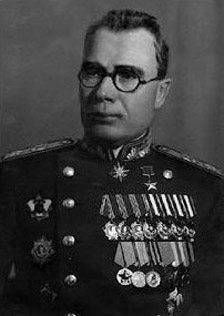
[Andrey Vlasov]
According to J. Lee Ready’s The Forgotten Axis, 3 million foreigners served in Germany’s armed services. This translates to 18% of Germany’s manpower. Among these 3 million were 200,000 Poles. This is a tremendous contribution that today’s German chauvinists should not ignore. Nearly a quarter million Poles served as civil authorities in the German GG (General Government). Some 100,000 were employed by the state railroad alone. What’s more, 620,000 German-speaking Poles were liberated by Germany, 80,000 of which served in the German armed forces. As we know from Himmler’s top secret Posen speech on 24 October 1943, many Slavic and part-Slavic Poles were scheduled to become Volksdeutsch provided they assimilated, acculturated and proved themselves loyal to Germany. A probable low estimate of Polish speakers in the German military is 200,000.
Between 1943 and 1945, nearly 4,000 Slovenes served as Gestapo volunteers (the Upper Carnolia Home Defense Force).
Luxembourg contributed 13,000 conscripts to the German war effort. They were considered Volksdeutsch Class IV even if this was not in fact true.
Ready asserts that 50,000 Czechs “suddenly remembered they were of German race,” thereby providing at least 5,000 soldiers for the German military. Whether some or most of these Czechs bore Slavic blood is unknown.
The Slovakians contributed 124,000 personnel to their own fascist cause or to the SS.
The Norwegians were mostly complicit neutrals. They provided just 9,000 uniformed personnel and their 7,000 policemen “did what the nazis required of them.” The Danes, in similar fashion, allocated just 16,000 personnel for security duties; only 11,200 Danes and 4,000 Danish Volksdeutsch served in German military units. So much for the mighty Nordics helping out their Germanic brethren!
In contrast, 69,000 Dutch men and women assisted the Germans in some capacity. But this may be an underestimate since the postwar liberal-democratic authorities arrested 113,000 men and 37,000 women for “collaboration.” What’s strange is that the Germans disrespected these Dutch Nordics – calling them “white Jews” and other disparaging things – and refused to allow NS-friendly Dutch nationalists and fascists to rule in their own country. The Germans ruled the Netherlands directly. On the other hand the Germans who arrived in the Kalmyck (Mongol) district of the USSR permitted the Kalmycks to rule themselves. These are just two examples of how different racial theory and racial practice were under German authority.
Moving on to Belgium, 22,000 Belgian Volksdeutsch served in the German military while a total of 170,000 Belgians served as harvest guards, policemen or soldiers. We know that 2,500 Walloons died on the Eastern Front.
France remained autonomous throughout the war. Even so and despite their postwar anti-Hitler frenzy, an estimated 600,000 French men and women served the Axis cause in some capacity.
In Yugoslavia too the Germans found collaborators and comrades. About “246,000 Yugoslavian soldiers and police, and about 46,000 Cetniks” sided with the Axis. And contrary to postwar myth about endless Greek suffering under Hitler’s tutelage, 50,000 Greeks helped the Germans, mostly against Soviet and other Allied partisans.
And Spain, that nation contributed no less than 47,000 soldiers to Hitler’s war effort in spite of Franco’s declared neutrality.
Iran and Iraq were both scheduled to become Axis members but the Allies nipped this development in the bud. Thus only a few thousand Arabs, Lebanese, Iranians, Palestinians and other Middle Eastern peoples were able to serve the Axis cause in some capacity.
While we’re on the subject of Muslims, according to Barry Rubin and Wolfgang Schwanitz, the Germans were celebrated as “heroes” and “liberators” by Muslims in the Caucasus in October 1942. The peasants publicly declared an end to the despised collective system. After General Ernst Köstring thanked these people for their support against the Russians, they lifted him onto their shoulders and tossed him in the air in celebration. They even gave cattle and sheep to the Germans in gratitude. Prayers in Arabic were said to Allah and they prayed for Hitler’s victory. This all happened because the Germans hosted an Islamic festival there in the Caucasus for the first time in a quarter of a century. (Many Armenian and Ukrainian Christians also celebrated the Germans as heroes and liberators.)
Today one can hear or read white nationalists disparage ‘nonwhite’ nations like Albania as a “third world dump,” but this “dump” as they see it contributed 30,000 of its citizens to the Axis war effort. These white nationalists need bite their tongues.
If we include the Vlachs as well as Jewish Ghetto and Gestapo members, then we may safely estimate that the Axis gained 10,000-plus collaborators from these two groups alone.
And now we come to the ‘Soviets’: the group that surpassed all others by and far when it comes to collaboration. Ready provides the following numbers:
Soviet Volksdeutsch - 60,000
Armenians 7,000 plus hiwis
Byelorussians – 80,000 plus perhaps 80,000 hiwis
Cossacks – 80,000 plus hiwis
Estonians – 50,000 plus hiwis
Georgians – 19,000 plus hiwis
Kalmycks – 5,000 plus hiwis
Latvians – 125,000 plus hiwis
Lithuanians – 68,000 plus hiwis
Moslems of the Caucasus (not Turkic-speaking) – 110,000 plus hiwis
Russians – 85,000 plus perhaps 120,000 hiwis
Tatars – 35,000 plus hiwis
Turkic-speakers – 110,000 plus hiwis
Ukrainians – 370,000(!) plus perhaps 360,000(!) hiwis
An unknown number of Siberians and Mongols
For some reason Ready does not include Indian, Chinese, Japanese, Burmese, etc. personnel or soldiers in his figure of 3.07 million foreigners and non-Germanics. All the same, such a figure cannot be dismissed as “rag-tag groups of traitors, anti-semites [sic], adventurers, fellow-travellers [sic] and misguided anti-imperialists” as Amazon reviewer Gareth “Boyd” Phillips of Islington, London would have us believe. Such assessments reek of ignorance. It is important to call people like him out on their ignorance, which contributor Weng Soon Yuen did on 3 December 2013. He wrote in response to Phillips:
“I object greatly to your evidently victors-biased accounts on the following aspects:
“1) Racism exist [sic] in all Western countries and Japan even though they apart
from the southern American states was [sic] not as explicit as in Germany. Colour
bar racism was widely practised and accepted in all European societies. The
only unique features of Hitler's racism are that it is based not only on skin
colours but also on genes and that there is also a racial hiearchy [sic] among
the whites of which the white Jews are at the bottom. I myself had spoken
to a number of Indian veterans who had served with the British army
fighting the Japanese in Malaya and Singapore. They had encountered the
rampart through [sic]latent racism in their units and suffered under their racist white
British officers and senior NCOs. Ironically, high caste Indians who are
deemed to be inferior to white Brits are deemed to be on top of Hitler's racial
hierarchy [sic]; a level higher than the other white imperialist powers like
the French, Italians, Portuguese, Belgians and Portuguese who are all non
Aryans. It is no wonder that Hitler is still greatly admired in many parts
of India and Mein Kampf is a mandatory read in leading Indian business schools.
“2) Both France and Britain had recruited hundreds of thousands of colonial
troops and auxiliaries to fight their battles in Asia, Europe and North Africa in
WW2. This is because they could not find sufficient indigenious [sic]
manpower to defend their extensive empires.
“3) Comparing or relativizing the crimes of Hitler, Stalin, the US and other
Western imperial powers is not only morally correct as it will give a more
balanced view of WW2 and world history but also serve as a reminder that the
victors of WW2 (i.e. communism and liberal democracy) still have not come
to terms with their murky past. Nazism is evil but it is not alone nor unique
but is just one of the many evils that has [sic] prevailed in the history of
mankind.”
The Germans and Vlasov
By the time Himmler sat down and spoke with Vlasov one on one it was too late to make a difference for Germany, but the most important thing is that Himmler humbled himself in such a way. D’Alquen, one of Himmler’s liberal-minded SS advisors and a writer/editor of Das Schwarze Corps, convinced him to meet with Vlasov. During the 6-hour meeting with the stalwart Russian, Himmler promised to make the Russian Liberation Army the future provisional government of a ‘free Russia.’
Naturally there were many Army and SS men who played a role in getting Himmler to come around on the Russian question. Fritz Arlt was pro-Russian and anti-Untermensch even though he was in the ‘Himmler camp’. He consistently advocated for the Russians. Captain Strik-Strikfeldt was among the most avid of the Wehrmacht’s Russian supporters doing everything in his power to advocate for Vlasov and his liberation movement. He was a genuine Slavophile. Other prominent Russian sympathizers and Vlasov advocates included Gottlob Berger (SS), Dr Erhard Kröger (SS), Dr Otto Bräutigam (Reich Ministry for the Occupied Eastern Territories, RMfdbO), Dr Gustav Hilger (German Embassy Secretary in the USSR), Colonel Heinz Danko Herre (Wehrmacht), General Kurt Zeitzler (Wehrmacht) and General Ernst Köstring (Wehrmacht), among others. And make no mistake, the boundaries between the military and the Party were fluid: high ‘Nazi’ representatives were in the Wehrmacht according to historian George Fischer.
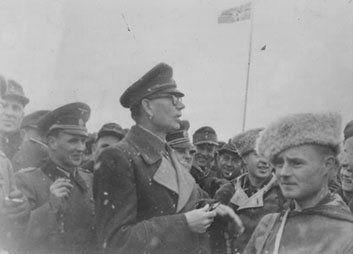
[Above: Vlasov and Russian volunteers.]
Let’s move on now to the competing schools of thought, per Fischer, about the Slavs. The schools can be divided into two main camps: the Ostpolitikers and the Utilitarians. The Ostpolitikers were so bent on exploiting Russia and her masses that they were unwilling to conceive of a post-Stalin organization of the USSR. Bormann and Koch were among them. Now, while all Utilitarians rejected this viewpoint they were divided into two camps: the Slavophiles who genuinely cared about Slavs and their autonomy and the Practicalists who urged good treatment of Slavs solely for the sake of German victory. Alfred Rosenberg and most of those in the Ostministerium were Utilitarians of one type or the other. While Hitler and Himmler started off as Ostpolitikers, both ended up as Practicalists. They were forced to become so owing to Germany’s military misfortunes. After Himmler met Vlasov he was still no Slavophile, but he was also not a Practicalist in the true sense. He fell somewhere between the two. He expressed respect and admiration for Vlasov and apologized to the Russian general for publishing and disseminating the pamphlet Der Untermensch. Himmler felt obligated to explain himself and told the Russian that
“The pamphlet you mention was intended to show a human type produced by
the bolshevist system, a type that threatens Germany just as much as it does
your country. There are subhumans in every nation. The difference between
our country and yours is that there the Untermenschen hold power,
whereas in Germany I have put them behind bars. It would ultimately be your
task to carry out this reversal of the situation in Russia also.”
(See Jürgen Thorwald, The Illusion, p. 213)
Himmler was impressed with the Russian general and conceded to almost all of his requests made at the meeting.
The following month, on 2 October 1944, Himmler summoned General Köstring to discuss the creation of a genuine Russian Liberation Army under Vlasov’s autonomous command. The Reichsführer at first couldn’t believe how many Russians were fighting alongside German troops when Köstring told him 900,000 to 1,000,000, an estimated 400,000 of which were ethnic Russians. Himmler nearly dropped his teacup when Köstring spoke, as he hadn’t heard a thing about this until now. Perhaps it was Himmler’s wakeup call not to fear Russians and Slavs so much since about a million of them were already fighting with Germany and had been for some time. By the end of their meeting Himmler informed Köstring that he’d like to begin with the formation of one Russian division. Köstring soon learned that Himmler had decided all this behind Hitler’s back and that everything depended on who won the upper hand in the end. As it turned out Germany ran out of time and Vlasov’s ‘liberation army’ never had a fair shot to prove itself in battle.
One of the most famous campaigns of WWII is the Ardennes Offensive or ‘The Battle of the Bulge'. Many ignorant system ‘historians' say that it was a useless sacrifice of German men and material and that it was an insane venture by Adolf Hitler. However, America's most famous General, George Patton, thought differently, as did General Eisenhower. I've read that both of them agreed that Germany had come close to victory in that battle, and if that would have happened it would have been a staggering defeat for the Allies. They went on to talk about the extreme consequences it would have had. One being that the Allies might have been pushed out of Europe. Another being that American public opinion might have grown sour to the war. This could have delayed the war by years in their account! Thoughts?
The Germans put up a remarkable resistance here, there’s no question. It has gone down in history as one of those rare occasions when a military proves itself worthy even in the face of defeat. Would historians have preferred a General Paulus-style surrender in which the majority of the Germans who ceased to resist were starved, tortured and/or murdered in disgraceful circumstances by their captors? The American authorities would have harassed, shot and starved them anyway, so their resistance was not in vain.
I like what Professor Ned Willmott, a lecturer at Norwich University wrote about this topic. It was so moving I included it in The Union Jackal. He wrote:
Had I been given the choice… I would have wished to have been a soldier in an
army that, at this time of which I write, had less than 24 hours of existence
remaining to it. I would have wished to have been a soldier in the
bodyguard of the Emperor, and been privileged to attend upon the Emperor
when he went to address his people, for the last time... There I would have heard
the Emperor ask forgiveness from his people for having failed to have
secured allies and thus condemned the Empire to fight this last dreadful battle
without help and without hope. I would have heard his people deny him
forgiveness, telling him that he was not to blame for the situation in which
the Empire found itself. What forgiveness was sought was then freely given,
and the Emperor spoke, telling his people that in life there were four things
for which it was worth dying: the Empire, the Emperor, the religion of the
Empire, and one’s own people. I would then have followed the Emperor
back...to the city walls that had protected the city...and there I would have
attended upon him as he made what was to be his last inspection, of
positions where in past crises there had been scores or hundreds but now there
were mere handfuls and finally to the positions where the enemy was
concentrated and where the main assault would be made the next day. As we
passed along...I know that we would have been in the company of the
sentries of the centuries, the emperors and generals of a millennium, who were
there to give comfort and support now that the last dreadful ordeal was at
hand.
I would have wished to have died in that last battle and to have died for the
Empire, for the Emperor, for my religion, and for my people. There are those who
would aver that to have died for the Empire in its last hours of existence
would have been futile and utterly without reason or sense, but that is
wrong, sadly wrong. To have died for the Empire in its last agony would have
given proof to History that even in its final extremis the Empire was
something for which to die, that the Empire even in Death provided Purpose.
And in the Memory of the Empire let there be Joy.
My view is this: the only time death in war is ever a waste of lives is if the soldiers do not believe in what they’re dying for. Given what I know about the Battle of the Bulge, I would venture to guess that the soldiers of the Reich very much believed in what they were fighting for.
Speaking of Patton, many conspiracies surround his death and the ‘accident' which caused it. History has recorded him as a fiery critic of communism and even saying that we were fighting the wrong enemy in WWII. There are numerous quotes from his diaries and letters to his wife lamenting that they had just destroyed a great race, that it was criminal the way he had been used to fight this war, and that the Germans were the ‘only decent people left in Europe.' Needless to say, the establishment turned against him for such thoughts. What do you think? There are some shady circumstances involving his rather convenient death. What's your impression of Patton?
Patton entered the war in Europe an arrogant Nazi-hater. He wanted to kill Hitler – the “paper-hanging son-of-a-bitch” – himself and he urinated into the Rhine River as an act of disrespect for Germany. By the time Eisenhower and his goon squad murdered Patton his attitude had undergone a 180. Once he got a load of what all had transpired on the continent as well as the behavior of average Jewish refugees he became more or less a ‘Nazi’ sympathizer. He certainly changed his views about the average German, as their behavior was second to none regardless of their circumstances. Where Patton expected to see ‘Nazified barbarians’ he witnessed civilized comrades in life just trying to survive and understand it all. He woke up from his American propaganda trance.
Patton grew to hate the Russians, the British, the Canadians, the Australians and even De Gaulle’s “Free French” armies, denouncing them as the “degenerate spawn of Genghis Khan.” Maybe the last straw was his suggestion to use SS troops against the Russians along with his latent anti-Semitism. (Perhaps this factoid is irrelevant, but his intelligence chief, Colonel Oscar Koch, was Jewish.)
Do I think Patton was murdered as a result of his change of heart? Yes. The single best book out there on this subject – by an author I personally conversed with via the Internet – is Target: Patton: The Plot to Assassinate General George S. Patton by Robert K Wilcox. He’s not only a kind man with a niche for writing an amazing investigative journalist account but he’s open minded about NS truth. Since I do not want to spoil the plot and findings for readers I will not detail everything here. But I’ll go over some of the mysteries.
Wilcox asks these questions, among others:
What happened to the five accident reports? They disappeared.
Why wasn’t an autopsy performed on a four-star general?
Why did Thompson, the truck driver, mysteriously disappear from Germany?
What happened to Patton’s Cadillac?
Why was Patton, one of three crash victims, the only one injured?
Patton was nearly killed in a number of strange incidents. He was warned that he was on a “hit list” and even told his family that he didn’t “expect to leave Europe alive.” What gives?
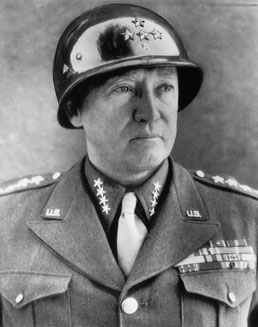
[Above: General George Patton.]
In 1944/45 Germany began to prepare for occupation by the Allied armies. Thus the Wehrwolf was born. Many, many organizations and famous people got involved in the recruiting and planning of this resistance movement, from Goebbels, Himmler and Ley to many lesser known people. They organized training camps for guerillas, stashed weapons and supplies and did all sorts of recruitment and training. Yet the movement itself was half-hearted. Some say the region wasn't good for partisan warfare. Others say the Germans were tired of war. Or perhaps without their Fuhrer they had just given up. Nonetheless, in their time the Wehrwolves managed to assassinate the Allied appointed mayor of Aachen, among other exploits. Your thoughts?
I have heard a number of theories related to the Wehrwolf resistance and only a few books have focused on it. The most credible account is that the Wehrwolf (also Werwolf) group was ad hoc and minimal. Heinrich Himmler ordered the formation of a paramilitary guerrilla organization in Berlin in November 1944. Its goal was to fight behind the Allied front in east and west Germany. The group became known as Unternehem Werwolf, or ‘Werewolves’. Most of the Werewolves were young Germans born and raised in the National Socialist system and educated in its worldview and who very much believed in the justness and value of this system. The group disbanded when Germany surrendered. Despite its short life and inglorious end, the Werewolves managed to pull off one successful operation, Operation Carnival, in the spring of 1945. They also caused the deaths of thousands of people, both directly and via Allied and Soviet reprisals they incited.
One of the leaders, Peter von Heydebreck, deployed his “Wehrwolves” against the Poles in Upper Silesia. He also formed a Wehrwolf parapolitical party with the objective of fighting Marxism and liberalism in favor of ‘National Bolshevist’ ideals.
In the fall of 1944 the NSDAP chancellery published a special edition of the novel The Wehrwolf, written by Hermann Löns circa 1914, intended for German guerrilla trainees and militiamen.
The Werwolf was a loose-knit movement that really only had one goal in mind: to conduct ‘Nazi’ guerrilla missions, vigilantism and various kinds of ‘suicide missions’. Leaders and inspirers of Werwolf included Goebbels, Hans Adolf Prützmann, Arthur Axmann, Martinn Bormann (Werewolf Radio), Robert Ley, Ernst Kaltenbrunner, Wilhelm Keitel, and Hermann Göring.
Given its structure and negligible accomplishments, I consider the Wehrwolf movement a failure. The greatest hurdles it suffered from were not related to terrain but to war weariness, the Western Allies’ overall good behavior and Soviet repression and terror. The Germans had been decimated morally and physically. They were brainwashed into believing that they alone caused the war and that they had mass murdered in the vilest ways imaginable millions of innocents, namely Jews. They were physically all but dead. Any reading of day to day accounts in war-torn Germany testify to the hunger, thirst, lack of sanitation, lack of basic amenities as well as daily rapes, murders and beatings by Allied occupiers. Many Germans were broken or demoralized by forced labor on one side and lack of jobs on the other. Freda Utley describes the deplorable business and personal conditions of average Germans in The High Cost of Vengeance. Both the British and Russians dismantled German factories and machinery and dispersed it all over Europe to reward those who fought against “Nazi evil”. Germans were not used to such hardship and this hindered any motivation to fight the occupiers when even soap was almost impossible to come by. A successful guerrilla movement in the Soviet occupation zone was impossible given the degree of terror and want in that sector. Though, the Soviets were not completely devoid of character. They recruited many former ‘Nazis’ to serve as authorities and policemen in the new German Democratic Republic. Plus many aspects of the GDR were not all that different from National Socialism, so why fight it? And the Western Allies proved likeable and friendly in the end, their system and worldview appealing to the average German. Most Germans reasoned that with representatives and material abundance like this, democracy and liberalism couldn’t be all that bad. There are other reasons why the Wehrwolf movement never took off but they would require a much longer answer. I recommend readers get Biddiscombe’s The Last Nazis and Whiting’s Hitler’s Werewolves. These two books provide the personal, psychological, tactical and other minor reasons why the Wehrwolf movement and resistance never took off as intended. In closing, I will add that Clausewitz recommended that peasants and peasants alone be recruited for la petite guerra (guerrilla warfare). Perhaps NS Germans were too urbanized and spoiled by civility to successfully wage an unconventional war?
The name Stalingrad has become synonymous with German defeat. 100,000 men surrendered, of which 95% were butchered and starved by their communist captors. One always hears how Adolf Hitler was an insane and bloodthirsty tyrant to give the troops held up in Stalingrad the order to hold their ground. I have, however, read some interesting accounts that conflict with that. One is by the famous historian A.J.P. Taylor. He speaks of how Hitler saved many more lives with the stalling action at the end of the battle of Stalingrad. By the troops in Stalingrad holding out they gave the other German armies in Russia time to regroup and refit. I also read of an attempt to free the encircled army at Stalingrad where Field Marshal Paulus seemed unwilling to participate in a breakout. In the account it spoke of the trapped German troops one day seeing battle in the distance outside of the city, growing closer and closer. They were elated when they realized it was their comrades coming to save them. They waited for the order to try to fight their way out and meet the attacking German army. But Paulus said they didn't have the supplies, and they did nothing. To their horror they watched the fighting get pushed back, further and further, until there was nothing. What are your thoughts on Stalingrad? How important was the German's sacrifice?
Let me begin by saying that Paulus was unqualified to fight that battle. Breaker McCoy has done an excellent job identifying Paulus’s issues and I will cover these in a moment. But first, let’s discuss the Soviet use of a biological agent at Stalingrad.
The Bolshevik regime began toying with bioweapons long before World War II. By 1928 the Soviets were developing typhus bioweapons and delivery systems; by the 1930s, the Soviets were researching glanders, Q fever, and melioidosis. Anthrax came later killing more than 100 researchers.
According to Ken Alibek, a former Soviet biological weapons developer for Biopreparat, tularemia was deployed shortly before the Battle of Stalingrad in 1942. The mysterious outbreak claimed so many German panzer troops in late summer 1942 that the German campaign in southern Russia “ground to a temporary halt.” Thousands of Russians also fell ill but such was the risk the Soviets were willing to take to defeat the Germans. Alibek is confident that this was no a natural outbreak. He studied the topic thoroughly and was informed by his instructor to “forget you ever said what you just did” after Alibek told him his conclusion: “The pattern of the disease…suggests that this epidemic was caused intentionally.” More than 100,000 Germans and Russians combined were infected with a disease that normally resulted in just 10,000 cases a year in Russia. Not to mention “so many men had first fallen sick on one side only.” This pattern suggests tularemia’s deployment as a weapon that had unexpectedly backfired on the Russians nearby owing to mobile vectors such as wind or rodents. Years after he discovered this information, an elderly lieutenant colonel² who worked in the secret bacteriological weapons facility in Kirov told Alibek that “a tularemia weapon was developed in Kirov in 1941, the year before the Battle of Stalingrad.” After the Russo-German war ended, the Soviets shifted from battlefield deployment to “deep targets far behind enemy lines,” an indication that tularemia was used and that lessons had been learned. Over a million Russians died defending Stalingrad, a strategic city that protected Russia’s industrial heartland in the Urals from enemy access. This level of sacrifice combined with the city’s importance (it was a COG, or center of gravity) apparently prompted Russian leaders to use disease as a weapon.
²Alibek relates that this lieutenant colonel also suggested that Q fever was used against German troops on leave in Crimea in 1943. The Luftwaffe could have destroyed the train containing the full contents of both the Leningrad and Solovetsky Island laboratories in 1941 when it bombarded Gorky, but it failed to do so. The train arrived in Kirov untouched.
In the light of this revelation the Germans’ sacrifice was not in vain. We’ve really no idea what horror might have been in store for Europeans had Stalin preempted Hitler or had he decided to wage war at some other future time. It is unfortunate for Germany that Paulus and Schmidt were the generals in charge but there’s no guarantee that any of Germany’s other old-school generals would have performed any better or differently. There was rampant defeatist mentality and anti-Hitler sentiment in the Wehrmacht leadership and this was often expressed via battlefield performance. But let’s consider a few more facts about Stalingrad from both the German and Russian point of view.
Germany lost for a number of reasons. Part of it had to do with poor decisionmaking on the part of Hitler and his generals. Of course General Winter (the weather) played a huge role, but again, even this could have been avoided if the Germans had displayed more caution and foresight in their decisionmaking. Sabotage by many a German traitor and general also played a role in Germany’s defeat. Against his better judgment, traitors in the High Command persuaded Hitler to send the 6th Army deep into Stalingrad, the 11th to Leningrad, and to leave the rest dissipated here and there and thus vulnerable to future encirclement. Luftwaffe assets were also dispersed. Whether Luftwaffe traitors like Harro Schulze-Boysen played any direct role is an area of research worth investigating. And of course General Halder was one of the worst of all: he withheld supplies at critical moments, lied and cheated at every opportunity. Effective Soviet intelligence and ineffective German intelligence affected Germany negatively too. The foreigners who marched into that battle with the Germans looked good on paper but they lacked weapons and their leadership was communist-infiltrated in many cases.
First and foremost, per Breaker McCoy the Germans could not provide the 6th Army with enough supplies to keep up with its demand. This resulted in a steadily declining overall supply position for the 6th Army, which was eventually reduced to starvation and virtually no ammunition.
Second we have the problem of Paulus. Paulus fought conventional style battles complete with repeated meat grinder frontal assaults. Such methods were worthless at Stalingrad and only wasted valuable lives and ammunition. Prior to Stalingrad two of Paulus’ subordinates – Wietersheim and Seydlitz – were compelled to undermine him because they found his old-school ways intolerable. Paulus’ inability to think beyond the tactical level led him to reject the offer of Luftwaffe paratroopers to drop along the Volga’s east bank and knock out Soviet artillery and supplies there.
Lutwaffe Colonel General Richthofen described Paulus’ 6th Army attacks as tentative and too small, more like combat patrols. It is no wonder his infantry was reluctant to advance without adequate aerial or artillery support. They weren’t stupid. What’s more, Paulus failed to utilize his thousands of Russian hiwis as combatants until mid-November. What was he waiting for?
Paulus’ Chief of Staff, General Arthur Schmidt, didn’t help any since he too was a tactical-minded dud. Neither general had the imagination or operational mind necessary to conceive of the obvious best strategy. According to McCoy, this would have been to pin the enemy in Stalingrad with the least number of forces necessary while forming a separate entrenched defensive line 30 to 40 miles west of the city. Such a plan would have shortened his supply lines and eased his ammunition shortage. Neither Paulus nor Schmidt considered this option.
On 22 November 1943, Generalmajor Wolfgang Pickert advised General Paulus to gather together all available forces and break out to the southwest. Pickert called out General Schmidt on his statements about a “Napoleonic catastrophe” denouncing Schmidt’s worries as “nonsense.” Pickert assured him that his motorized flak division could carry their weapons and ammunition anywhere and provide wide ranging support. And Pickert was no foolhardy man: he knew that supplying the 6th Army by air was impossible and he made his view known. Though also a tactical thinker, even Paulus’ immediate superior General von Weichs advised him that a breakout was the only viable option. But Paulus never acted.
The next day, 23 November, General Walter von Seydlitz-Kurzbach’s northern defense positions were hastily abandoned without his order. His hopes to assist Paulus with a breakout were dashed in this way. The 94th Infantry Division was overrun and decimated by Red Army troops during the movement to the rear.
Paulus and Schmidt further failed in the following ways. They failed to request that the freed-up German 11th Army be moved as a strategic reserve behind Army Group B to the west of Stalingrad and north of Rostov in mid-July 1942. They failed to restructure the 6th Army inside Stalingrad by replacing 5 German divisions with 5 Rumanian divisions. The veteran German mobile and infantry troops could have counterattacked and provided flank protection. Paulus and Schmidt did not reshuffle troops for massed antitank and artillery barrage against enemy incursions southwest of Stalingrad, which they could have done. Nor did either commander exploit the huge mass of supporting artillery and flak resources available to them, nor the aerial superiority in the first week of October 1942. Finally, they could have withdrawn and reshuffled before the first week of October 1942. They didn’t.
Another issue at Stalingrad was that the Germans simply did not have enough antitank guns. Too many individual Germans died owing to this scarcity.
Soviets at Stalingrad
Now we’ll examine the Soviet side. Per McCoy, Soviet cavalry distinguished itself in offensive fighting at Stalingrad. These cavalry divisions were equipped with tachankas, light animal drawn wagons that mounted several heavy machine guns. These could be fired directly from the wagons. The first operational duty of the Soviet cavalry, commanded by colonels, was to enter the breakthroughs made in the Southwest, Don and Stalingrad fronts. The cavalry would then carry out Deep Battle: smash the German reserves and staffs, cut their communications, and ultimately close the circle being created around them. This Deep Battle operation was intended to put as much distance as possible between any relief forces coming along and the 6th Army to prevent any linkup or breakout.
The next Soviet advantage was their antitank defense. The Germans were too reliant on tanks at Stalingrad. The Russians knew about this German keenness for tank battle and they were prepared. Russian priorities thus consisted of active fighting against German armored weapons and protection of Russian antitank weapons. Artillery was in fact the backbone of Soviet defense. It succeeded because the Soviets met the two main factors for effective antitank defense: depth (20 kilometers in this case) and organized fire. The Soviets fired in successive waves at various depths depending on circumstances. But the real key to their success was the force and concentration of their fire. Furthermore the Russians kept mobile artillery units in reserve to serve as antitank weapons when the need arose.
Lastly, the Soviets recognized the need for a control organization between their fronts. Superior operational generals were sent in to coordinate the operations of groups of fronts in the name of STAVKA (Red Army High Command Headquarters). They used this technique at Stalingrad and for the remainder of the war.
In the end, Germany lost 12 infantry divisions, 3 motorized divisions, 4 tank divisions and 1 flak division. The Soviets lost 2 tank corps, 18 guards rifle and rifle divisions, and 1 NKVD division. Thus while both sides lost about the same number of divisions, the loss hurt the Germans much more because they had fewer masses to recruit from and much slower industrial production capability. They also lacked a capitalist partner that churned out tanks, planes and armored vehicles ‘round the clock. Furthermore, in the summer of 1941 Stalin stopped terrorizing and micromanaging his commanders, instead allowing them to flex their own meritocratic muscles. So while Hitler trusted his commanders less and less at this time, Stalin trusted his more and more. Not even Stalin’s notorious political commissars were allowed to meddle in military strategy any longer. These changes in ’41 undoubtedly assisted the Soviets in their victory at Stalingrad as well as in their many victories afterward.
In your book ‘Black Nazis II' you explore a shocking and fascinating history of WWII virtually unknown to the Western world. Can you tell us about this intriguing book? When did you first learn of the many non-whites serving in the German armed forces, namely the Waffen-SS?
The first time I ever heard of non-whites serving in the German armed forces (both Wehrmacht and Waffen SS) was when I came across photos of such on the Internet. And then I found out about Antonio J Munoz’s book The East Came West via the Internet. I don’t remember where I first came across this book, though it was probably featured or referenced on one of the Axis military history sites like Axis History Forum (AHF) or feldgrau.net. I still consider Mr Munoz the pioneer of this area of World War II history despite the minor flaws one will encounter with his editing and research. I was able to acquire every one of his books over the past 9 years and I would not sell any of them for any price.
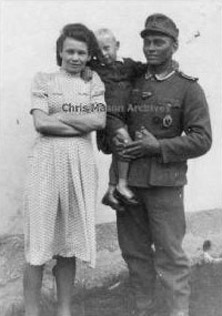
[Above: An example of a non-white volunteer (and family). ©Chris Mason Archives]
This one book, The East Came West, changed the course of my life because it inspired me to enroll at Norwich University and it became the precedent of my own research in this area. My first book, Black Nazis! A Study of Racial Ambivalence in Nazi Germany's Military Establishment: Non-German Ethnic Minority and Foreign Volunteers, Conscripts, Laborers and POWs, 1940-1945, was inspired by Munoz’s work. It is an expanded version of my master’s thesis, which was well received by my former thesis advisor, Dr Mike Wadyko. However, upon publication of this book and its subsequent affiliation with “revisionism,” my thesis advisor refused to assist me again and Norwich University no longer allows any students to write theses on the Waffen SS. This action was a direct result of my paper being published as a book and utilized by the “historical revisionist” community to enlighten readers in this regard.
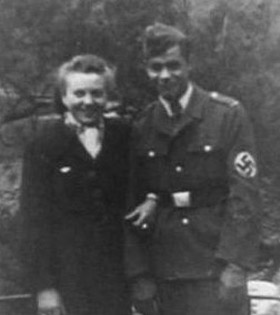
[Above: ‘Black Nazi’: Ewan Ngango (Courtesy of Serge Bilé)]
Here is what one former Norwich student, a young man who attended Norwich after I graduated, wrote me:
“Hello Veronica,
I am delighted to hear back from you. I would love to hear more about your
‘battles’ with Norwich after graduation. I battled with the pigheaded Capstone
Czar [Dr John Grenier] as he so declares himself. My first Capstone advisor
had no problem with me writing a paper about the Waffen-SS as long as I had a
plethora of primary sources, which I did (all translated into English since I cannot
read German yet; I desperately want to learn German, but I have just not found
the time or method to do so yet).
Anyway, my first advisor had to leave the program in order to accept a job at the
[removed]; thus, I was stuck with the Capstone Czar as my advisor. When I sent
him my thesis, he replied with a scorching email in which he stated that my topic
consisted of Nazi-love and possible Holocaust denial. He even threatened me
with expulsion if he caught me writing with Nazi-love or Holocaust denial
tendencies!
I stayed calm and refused to fall into his trap. I simply escalated this issue to the
director of Military History at Norwich. He assured me that he would talk to the
Czar and assign me a new advisor. The new advisor and director ‘talked’ me out
of writing on the German military because I could not read ‘true’ primary sources
that were written in German. I knew that it was a bunch of BS, but I decided that
I came this far that I had better do what they want in order to graduate. Thus, I
‘chose’ a topic on the Korean War, which was actually quite interesting as it
turns out.
By the way, I graduated from Norwich in [removed] of [removed]. I also have an
associate’s degree in electronics from the [removed] and a bachelor’s degree in
history from [removed].”
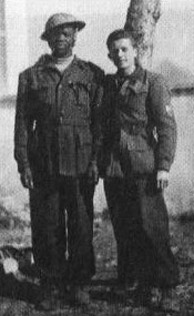
[Above: Peter, an Afro-Italian immigrant who converted to fascism (Courtesy of Serge Bilé)]
My second book, which is out of print, is Warwolves of the Iron Cross: A New Look at Hitler's Armed Forces. (The softcover edition is entitled Triumph of Diversity: A New Look at Hitler’s Armed Forces. It too is out of print.) This book is the first book in my Wehrwolf series, each volume of which builds upon the previous volume in succession. This first volume answers criticisms directed at my first book, Black Nazis, and expands upon my thesis in more detail. The reason this book is no longer available is because the new introduction to Black Nazis II (the second edition, second printing of Black Nazis) is essentially the same information presented in a more articulate and concise manner.
Unfortunately not much is known about these black Africans even now, and less was known about them back in 2006/07 when I commenced my research. What I have found is intriguing, as most of them fought with the Free Arabia and Free India legions of the Wehrmacht. At least one was in the Waffen SS. Norbert Désirée, a black African originally from Martinique, served in the 10th company of the 3rd battalion (LVF). Some Africans also voluntarily served in the 950th (Indian) Infantry Regiment. Mandenga Ngango, an Afro-German man, was a Luftwaffe officer. Horst Sabac el Cher was a Stahlhelm member of relatively high rank in 1935 (he had two diamonds on his collar tab).
There are numerous photographs I’ve found of Africans, mulattoes and suspected mulattoes, none of whom have names, ranks or other information accompanying them. This makes further research extremely difficult, if not impossible. In fact, Serge Bilé has come across similar problems with this area of World War II research. In an interview with EkilAfrica we read the following exchange:
Ekilafrica.com: Have you had the opportunity to meet some of [these blacks]?
Serge Bilé: Unfortunately not. I had the opportunity to speak to one of them,
now 92 years old, over the phone but there is some discomfiture about this.
I contacted another but he too refused to meet with me and would not even
speak to me by phone. We feel that there is shame in this regard, a fear of testifying.
Ekilafrica.com: What image do Afro-Caribbeans who are familiar with this
period of history have of these compatriots of theirs?
Serge Bilé: Whenever it is mentioned they are amazed. When I tell this story they
do not believe me, as it seems so unlikely. I started talking [about this] in
2004. Nobody believed me until I provided them with the evidence.

Mr Bilé is not alone of course. I have long received mocking reviews of my work and even vicious ad hominem attacks from the ‘white nationalist’ community, Amazon book reviewers and Axis history buffs for revealing what I have. One online German chauvinist in particular snipes that my research is “much ado about nothing” while her ‘white nationalists’ falsely claim that I am “married to a black man.” These degenerates have even given my imaginary black husband a name!
Needless to say, Mr Rodney Martin, another ‘white nationalist’, bought three of my books. Mr Faurisson purchased Black Nazis and applauded it as excellent. Max French of The Ugly Truth radio network purchased all of my books. David Irving (via Max French) requested all of my books. Daniel W. Michaels, an IHR contributor, purchased Hitler’s Most Significant Speech. And numerous other prominent personalities and historical revisionists such as Paul Grubach, the late Harrell Rhome, M Monikowski (Polish revisionist and translator), Brian Ezrin (Jewish), Patrick McNally, Dr Victor S Alpher (Jewish), Antonio J Munoz, and even a Microsoft employee (who had her books delivered to 1 Microsoft Way) have all purchased one or more of my books. And the last new, original and signed copy of Black Nazis sold for $800.00 on Amazon.
As we now know, some blacks were Abwehr (military intelligence) and Gestapo (secret state police) spies and agents, several were in the Heer (regular army) and still others assisted indirectly, such as via the “Back to Africa” movement of Marcus Garvey or via pro-Axis propaganda such as that put out by Lawrence Dennis. Historian Gerald Horne revealed how several hundred black Africans were detained at Drancy, France as “fascist intriguers,” and Serge Bilé of France recently published a book about these “dark executioners.” Mr Bile’s book features photos and biographies of several of these collaborator men and women, including Norbert Désirée (LVF), Louis-Joachim Eugène (LVF), Henry Lémery (former Vichy Minister of Colonies), Germaine Lubin (mixed-race German-Kabyle/Guyanese singer), Ewan (Wehrmacht enlistee) and Mandenga Ngango (Luftwaffe officer), Marcus Baarn (Abwehr spy), and Aurélien Hoareau (Gestapo recruiter and agent).
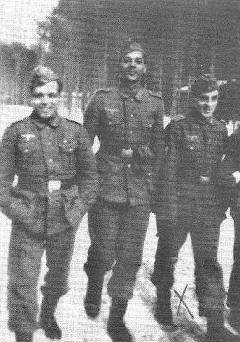
I might mention here again the countless Jewish and mixed-race Jewish persons who were allowed to serve in the German armed forces, many of whom were even declared “German-blooded” by Hitler. The NS authorities were not as staunch in their racial views as historians have led us to believe.
Historian Christopher Hutton:
“…the idea of a racial or ethnocentric key to all areas of human knowledge,
which was seen by many would-be ideologues as defining intellectual Nazism,
eventually faltered. Ultimately the dominant model that emerged in Nazi
Germany was the overt separation of ideology from science, and intellectual
discussion in Nazi Germany followed wider trends in European and western thought.”
More and more information is becoming available as more researchers look into this taboo and almost completely ignored aspect of World War II. My hope is that my book has inspired (and will continue to inspire) others to find out more and dig deeper for more information.
The bulk of the African collaborators were from France, Guadeloupe, Antilles, Martinique, North and East Africa (Tanganyika, for example), the Middle East, Italy and even Germany proper. The majority of mulattoes, like the Ngango brothers, Hans Hauck, Werner Egiomue and the Sabac el Cher brothers, were born and raised in Germany. There may be other countries of origin for some of these black collaborators, but more research is needed in this area.
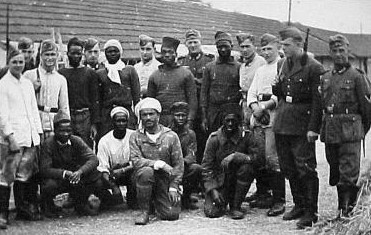
[Above: Africans with German soldiers (Courtesy of mourningtheancient.com)]
Here is a bit more from Bilé.
Serge Bilé: I was confronted by a scene from the Louis Malle film “Lacombe
Lucien”, released in 1974, featuring a black man torturing a person for the
Gestapo. This scene struck me. So, in 2004, I commenced research on the role
played by certain Afro-Caribbeans alongside the Nazis. I discovered that
some of them left everything they knew and went overseas to join Nazi
Germany.
Ekilafrica.com: As surprising as it may seem, some [of these men] have even
attained martyr status: for instance, Adolfo Prasso, a Métis Italian-
Ethiopian. So much so this envy exists that a bust in his likeness, present today,
was installed in Mongardino, a commune in the province of Asti in the
Piedmont region of Italy. Hitler would never have done that. So why Mussolini's
Italy, nominally allied with Nazi Germany?
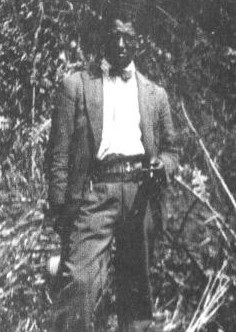
[Above: Adolfo Prasso (Courtesy of Serge Bilé)]
Serge Bilé: These are the great mysteries of history. We do not know why such decisions are made, some of which we least expect to break through existing barriers ... In the book, his cousin claims that this statue is an honor to Prasso and his family.
Ekilafrica.com: The Afro-Caribbeans did not hesitate to participate in the armed forces of Hitler despite the Nuremberg Laws. Was it money that created such motivation? Didn’t some of them join out of real conviction?
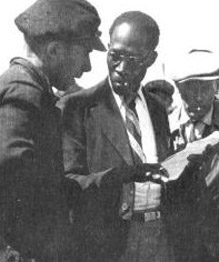
[Above: Africans assisted Germany’s OT (Courtesy of Serge Bilé)]
Serge Bilé: It was more than money. Many blacks aimed to escape these laws and the repression. Some of them remained [in Germany]. But when deciding to remain, they had to make themselves very small, to go unnoticed. Some managed to sidetrack the laws and joined the Hitler Youth. It was a way of saying: “We are Germans like the others and we want to defend our country!” They harbored their share of nationalism, including admiration for Hitler. Norbert Désirée was motivated by money and nationalism. He wanted to see France rise. As well, Norbert was clearly anti-communist and did not want to see Bolshevism in Guadeloupe.
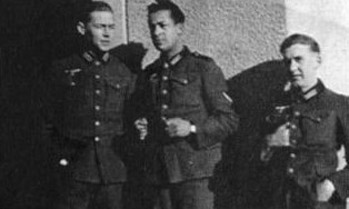
[Above: Black Nazi’: Mandenga Ngango (Courtesy of Serge Bilé)]
Ekilafrica.com: Was this mentality equivalent to the reputedly fascist Afro-Caribbean populations in Italy and Spain who took up arms for Franco and Mussolini?
Serge Bilé: There are no real differences. Here too the desire to defend the country took precedence over everything else, as with Prado who struggled to join the Italian army. There are those who were born in Italy and wished to integrate with the fascist parties and those like Peter who arrived later and became Italian fascists via the Stockholm Syndrome. In being close to the fascists they eventually became fascists themselves.
(See http://www.ekilafrica.com/Index.asp?affiche=News_Display.asp&articleid=2300&ID=90&SID= )
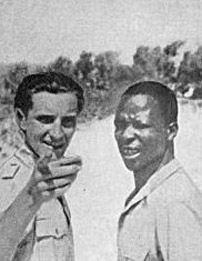
[Above: Hans-Joachim Marseille with his friend and crewman Matthew 'Mathias' Letuku]
Moving on, many of these black and mulatto men saw combat. The black man who Wimmer discusses in his memoirs – sworn-in at Stahnsdorf and served with Special Commando Wimmer – saw action against partisans in Greece. Horst Sabac el Cher, a medic, disappeared in the North Caucasus area. One black Wehrmacht member allegedly perished near Moscow and was “buried in the snow.” Hans Hauck saw action on the Russian front from 1942 to 1945. (He survived the war.) Norbert Désirée, who was also an OT Truppführer, and Louis Eugene saw action via the LVF and Wehrmacht on the Eastern front. Hans Massaquoi would have seen some action, but he refused to fulfill his Volkssturm obligation on the home front after he was given his gun and told where and when to report for duty.
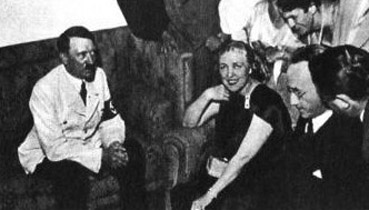
[Above: Germaine Lubin pictured with Hitler in 1938 (Courtesy of Serge Bilé)]
Most of these men also did well after the war. One of the Sabac el Cher brothers survived the war unscathed. He had a son, Axel, to care for and resumed his musical career. Two Afro-German sisters, Erika and Doris, both worked for Wehrmacht installations during the war, and both did quite well after the war. They performed in musicals and films. Désirée survived the war and earned his living as a dock worker in France. Hans Hauck, Werner Egiomue and Hans Massaquoi all survived the war. Massaquoi moved to Liberia and then on to the United States after the war. Hauck and Egiomue remained in Germany.
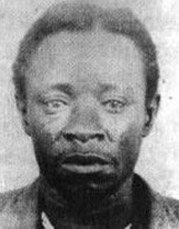
[Above: ‘Black Nazi’ spy Marcus Baarn (Courtesy of Serge Bilé)]
I’ve read that during WWII many Arabs and Indians saw Adolf Hitler as a divine force. There was a saying that roughly went: ‘In Heaven is Allah, on Earth is Hitler.’ To this day there are Arabs who still honor Adolf Hitler, even having his picture on their walls. With the last few questions in mind, it is interesting that we are taught in school that if you don't have ‘blond hair and blue eyes' the ‘Nazis’ would have exterminated you. That's not an exaggeration, as crazy as it sounds. I remember asking my high school history teacher ‘Hitler didn't have blond hair, did he want to exterminate himself?!’ and the answer, of course, ‘well he was crazy!’. The truth sure is different than we were taught. Why do you think ‘they’ have gone through so much trouble, all of these years later, to hide the truth?
I’m glad you mentioned the Indian attitude about Hitler. There was an armed Indian women’s regiment that the Germans trained as guerrillas. Indians served on German U-boats and even marched at the German sponsored rallies. Photos of all these Indians in German uniforms are available online. All swore an oath to Hitler. Had there been more time and had Hitler shown earnest interest from the start in Indian independence, these Indian troops might have become a formidable pro-German army. India boasted a population of 450 million during World War II, most of whom wanted independence from British tyranny.
Indians fought with Germans for independence from Britain. Churchill murdered between 3 and 7 million Indians in a Holodomor (death by starvation) in 1943. This Brizi genocide is explored in Madhusree Mukerjee’s Churchill’s Secret War.
One Indian gentleman who maintains a blog on the Internet wrote in August 2011 that Adolf Hitler was responsible for Brizi decolonization, India’s freedom, and the freedom of some 100+ other countries and billions of people worldwide. Can readers imagine a white person saying this about Adolf Hitler in 2011? A ‘white nationalist’ wouldn’t even credit Hitler with this (since it was not in white people’s interests to destroy the Brizi Empire). A ‘white nationalist’ probably wouldn’t like the fact that Hitler made NS Germany into an Islamic mouthpiece to inflict blows unto Jews, Brizis and anyone else who opposed a relatively peaceful Arabo-Islamic Middle East.
Basically, Hitler was no different than any other leader in world history. In fact he was more tolerant and less warmongering than many before and since his time. There was nothing particularly negative or bad about him or his movement and it is this normalcy that the Albionist-Zionist authorities and court historians wish to conceal. If we all see Hitler as more or less an average leader who was more loved and admired than despised, then it throws everything we’ve been told about him and his so-called ‘crimes’ into question. And this is what the establishment wants to keep us from doing: inquiring into what really transpired in the transfer and labor camps. The more we probe the more we question, and the more critical we become of just about everything we’re told by authorities.
For example, my current knowledge level regarding Treblinka has caused me to see Caroline Sturdy-Colls’ geological investigation there as juvenile. Since there was no excavation her findings must be dismissed as pure speculation. And even if there are bones in the earth at the Treblinka site, they must still be tested to prove that they are Jewish bones and that these bones show some trace of poisoning or trauma (which would indicate torture and/or physical suffering). Sturdy-Colls did none of this but simply claimed that she found pits below the surface that are approximately the same size as those described in Jewish memoirs, etc. To the discerning mind her conclusions are unscientific and unacceptable. But to the mass mind that is swayed by emotion Sturdy-Colls didn’t even have to go to Treblinka to prove there are Jewish graves full of Jewish holocaust victims there. She merely had to say it.
So, in a nutshell, ‘they’ think along the following lines:
Hitler=normal ~ holocaust=questionable
If Hitler is seen as a good man and normal leader who made war like everyone else before and since, then maybe he didn’t really order the extermination of Jews. And you can see how this undermines everything that has transpired since the end of the war. Not only does it make America and Britain look like devils (i.e. if Hitler was innocent of the holocaust and other alleged heinous crimes) but it undermines the Jewzi claim to Palestine. After all, the Jewzis have been able to use the holocaust as a variable weapon against the entire world:
the official holocaust narrative induces guilt within the West and nearly all peoples
of European descent, notably since this Euro-Western megacrime trumps all
other crimes in human history (the guilt card);
the official holocaust narrative legitimizes the apartheid ethnostate of Israel since
there will ‘inevitably’ be ‘another holocaust of Jews’ if they are not in a
perpetual state of offense against the Arabic-Muslim world (the victim card);
the official holocaust narrative keeps the West from disavowing its support for the Israeli ethnostate (the perpetual indebtedness card)
the official holocaust narrative is profitable (the eternal reparations card)
I could go on with more examples of how the accepted holocaust narrative harms us all for the exclusive benefit of Jewzism, but I think you get the idea. Though, I suppose I should mention that the holocaust narrative harms in another less expected way by making non-whites and Jews hate whites, the West and especially Germans. If these three entities are innocent of this megacrime, then this holocaust induced hatred and the crimes and acts that accompany it are baseless. (For example, the numerous violent attacks on the IHR by the JDF – a Jewzi terrorist group – in the early 1980s and the vicious beating – nearly to death – of revisionist Robert Faurisson.)
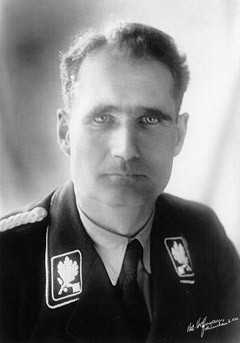
[Above: Rudolf Hess]
I'm curious to hear your thoughts on Rudolf Hess... 46 years of imprisonment. The evidence is overwhelming that he was murdered. What did the Allies think he knew that they were so worried about him revealing? There are records on Hess in Britain that are sealed until 2017! Any theories on why all the secrecy?
Oh yes, I do believe the Brizis have much to hide in this regard. Incidentally I broached this topic with Deanna Spingola in a radio show a few years ago.
The answer to this mystery can be found in Louis Kilzer’s investigative masterpiece, Churchill’s Deception. Since I provided the gist of what Kilzer presents in his book in a previous answer, I will provide more detailed information here.
Before I begin, I want readers to know that Hitler met with Deputy Fuehrer Rudolf Hess in almost complete secrecy for four hours on 5 May 1941. The following phrases, which will make sense shortly, were overheard by Adjutant Alfred Leitgen:
“Albrecht Haushofer”
“Hamilton”
“No problems at all with the airplane.”
“simply declared insane!”
Alfred Rosenberg also met with Hess in complete secrecy on the morning of May 10th. Hess commenced his flight to Britain that evening, at 6 P.M.
“Churchill’s Deception”
Churchill wanted Hess to fly to Britain. He was the mastermind of the illusive “British Peace Party” which lured such prominent NS leaders from Rosenberg to Hitler into believing that a genuine and powerful group of peacemakers existed in Britain. This “Peace Party”, as Kilzer calls it, had the ability to oust Churchill for the sake of keeping the peace in Europe. Or so the ‘Nazis’ thought. Hitler, Göring and a number of civilian and government mediators were involved in various negotiations and meetings with supposed “Peace Party” representatives in the lead-up to the Polish invasion. And the illusion didn’t end there.
Hess flew to Britain to get Churchill on Hitler’s side against Stalin. He knew that if Britain came out against the USSR in favor of Hitler, there would be no major war. Stalin wouldn’t dare risk it before he secured an alliance with the Western Powers or seized all of east Europe. The problem with Hess is that he misunderstood Churchill and Brizi aims. Churchill wanted more than anything for Germany and Russia to go head to head so that Britain could maintain its longstanding divide and rule hegemony over Europe. The last thing Churchill wanted was peace on the Continent. So he had his ‘peace party’ cronies tell Hitler one thing and Stalin another.
Now, a most interesting thing happened when a certain Welsh doctor, Hugh Thomas, inspected the imprisoned Rudolf Hess. It is well known that Rudolf Hess had a scar on his chest. He had also been shot in his left lung, an injury that would have left scar tissue inside and out. However when Dr Thomas examined Hess and even took X-rays on his lungs, etc., no injuries of any sort were found. No beer mug scar, no bullet entry scar, no exit scar, no rib damage and no scar tissue in the lung. This is why Thomas wrote that Spandau Prisoner No. 7 was not Rudolf Hess in 1977. Thomas assumed that Germany, being ruled by diabolical demons, had sent over a double. Since this was not the case the real question is how the Brizis kept this mysterious double from talking. Was their double mentally off? Drugged into insanity? After all, ‘Hess’ exhibited bizarre behavior at the IMT. Some of his fellow NS comrades couldn’t believe it was him. Maybe this is why the “crazy Hess” myth was introduced: If Allied historians could portray Hess as a madman obsessed with occult postulation and astrology, then ‘his’ IMT behavior and everything that followed at Spandau could easily be explained. For example, if the man at the IMT claimed not to be Hess, the Allies only had to reply, “He’s nuts!” Needless to say the man at Spandau did not allow his family to see him for 28 years(!). This is odd for a man who loved his wife and son dearly.
So, why was this Hess strangled? Well, do we really know that he was? This may be another Brizi coverup…for their ultimate coverup: the murder of the real Rudolf Hess. Churchill needed Hess to frighten Stalin and fool the NS leadership simultaneously. Per Kilzer, the British used Hess “to negotiate a war that killed twenty million Russians,” so “it was important that Hess not be available afterward to tell of it.” The beginning of the Cold War was October 1942, the month and year when Stalin realized he’d been had by Churchill and accordingly sped up his planned offensive against Germany. His delays up to that point – awaiting Churchill’s promised “second front” – nearly cost him the war because Hitler got the jump.
Stalin only stalled prior to Hess, as he thought he had time and a genuine ally in Britain. Stalin kept begging Churchill to open a second front against Germany, which Churchill promised he’d do as soon as he could but which never happened. Of course Stalin could not help but notice the Allies’ sudden odd behavior post-Hess. Hess thus became Churchill’s trump card against Stalin: if Churchill was negotiating a peace deal with Hitler via Hess, what would Stalin do? Who could he turn to? He had already defied several tenets of the Russo-German Pact thereby angering Hitler. Indeed Stalin was compelled to postpone his offensive until he knew where Britain stood. As always, Britain stood for Britain alone and she would, as always, pitch every nation she could one against the other to inherit the spoils of all.
Now, there was one key difference that lay at the heart of Hitler’s and Churchill’s respective willingness to negotiate a peace. Hitler, not Churchill, wanted a genuine peace deal, but one that would allow Germany to keep at least some of what her people had shed their blood to attain. Hitler thus wanted a quick end to hostilities and was even willing to allow Poland to exist as a sovereign state, though smaller than she was before. Hitler came to the table with an honest and genuine proposal, though clearly not one lacking some imperialist intent. In this Hitler was open about his aims. Churchill, on the contrary, came to the table with fingers crossed. His aim was neither peace nor a speedy end to the war but the prolongation of the war for as long as possible. The longer Churchill could delay and string both the Soviets and ‘Nazis’ along, the better the situation was for Britain. Thanks to Hess, Churchill knew that Germany was planning to attack the USSR and that Germany wasn’t up for such a venture on its own. But neither was Stalin!
Anyway, Hess’s genuine peace effort informed Churchill of Hitler’s intentions as well as his misgivings about his own readiness. Churchill then made sure that no one else knew what Hess had conveyed and stalled as long as he could to ensure that either Hitler or Stalin struck first. As Kilzer put it: “America and Russia would fight the war that England couldn’t.” All Churchill had to do was keep Stalin in the dark about Hess and keep stringing the ‘Nazis’ along about the “peace party.” Post-Hess Stalin realized he could no longer wait. Was it Brizi silence combined with Hitler’s decision to suddenly end his blitz over London on 10 May that prompted Stalin to get going? Was it the RAF’s sudden apparent ‘cease fire’ – the RAF was absent after the Hess affair – over Europe that scared Stalin? We may never pinpoint the exact cause for Stalin’s sudden action, but the vozhd started moving his offensive installations to the front lines immediately after Hess’s crash landing. That much is clear.
Of course, the Duke of Hamilton (blackmailed with the threat of treason) and Karl Haushofer’s son, Albrecht, (a double agent) also played their respective roles to foment war on the Continent. The Duke of Hamilton was supposed to meet Hess upon his landing. Hess had memorized the entire route in case of radio failure and had even managed to secure extra fuel tanks to his airplane. Flying as Captain Horn, Hess was told that there was a landing strip near the Duke’s estate but no such landing strip existed. This is why he parachuted out and his airplane crashed off course. He was taken into custody by the Home Guards and requested to see the Duke of Hamilton. He had a very important message and a letter for him. That letter has since disappeared. Hess revealed his true identity only when the Duke arrived to meet him. Hess then told the Duke that his friend Albrecht Haushofer had referred him: “My friend…told me you were an Englishman who would probably understand our point of view.” Hess had come with proposals for peace between Britain and Germany and wished to begin negotiations with the Duke’s ‘party’, i.e. the anti-Churchill Cliveden Set. But the Peace Party was only a chimera to lure the ‘Nazis’ into a trap; Haushofer and the Duke of Hamilton had been the bait all along. Other lures and liars included the Duke of Windsor, Samuel Hoare, D L Blackford, T A Robertson, the Marquis of Clydesdale, and Frederick Winterbotham.
Bottom line: Hess told the British everything about Barbarossa, including the intended start date. And Hess had not been in communication with Hamilton (who was compromised) prior to his arrival, but with the British SIS.
Hitler acted quickly to discredit Hess for the sake of damage control. What would the world think – what would Stalin think – if they found out he was trying to make peace with Britain and that he was about to turn on his Russian ally? They would think Germany was weak and crazy all at once and that Hitler was having second thoughts and/or regrets about what he’d so far done. Hence Hess was declared “crazy”.
The Brizis remained mum about the ordeal which caused everyone to wonder in amazement about what had transpired. Stalin, the paranoid brute he was, suspected British treachery; he feared that the two nations were in the process of some sort of secret alliance. But the Brizi government remained tight-lipped.
Even Goebbels and Ciano were confused by the silence. No atrocity stories signed by Hess? No statements of denunciation of Hitler from Hess? Nothing about Hitler begging Churchill to be his BFF or that Hitler was about to turn on his Soviet buddies? Nothing from Hess at all? It was unbelievable that the British would not use him in some sort of propaganda campaign. But they didn’t. And Stalin, well, he had to move now because neither Churchill nor Hitler could be trusted. The silence was killing him too and Czech intelligence only made him more paranoid, which we’ll revisit in a moment.
Stalin Moves
Stalin ordered that all offensive installations be moved to the front three days after Hess’s landing in Scotland, on 13 May 1941. (Hitler’s original Barbarossa strike date was 15 May while Stalin had been toying with his preemptive offensive for the previous nine months.) And three days after Hess’s landing, the Russian General Staff ordered that seven Soviet armies secretly begin their move west. On 20 May the American military attaché in Moscow reported the following:
“Yugoslavia Military Attache stated the Chief of the Red Army said to him the
Soviets will fight Germany later and are waiting for the United States to
enter the war, and that the Soviet Government distrusts England and
suspects Hess flight as effort to turn war against U.S.S.R.”
And it gets even better! On 22 May, J. Edgar Hoover, FBI Director, penned a memo to the US State Department that
“A Russian source has advised with respect to the arrival of Rudolph [sic] Hess in
Scotland that in his opinion this occurrence was predicated upon
instructions of Adolf Hitler for the purpose of arranging a contact with Liberal
Communists or the remnants of the Cliveden Set so that they, in turn, could
contact Prime Minister Churchill and thereby influence the British
government to negotiate a peace with Germany and thereafter combine forces
with Germany to attack Russia.
“It was stated that the Russian position was very plain, as a constant rearmament
program had been in effect in that country for some time, although Russia is not
disposed to picking a quarrel with Germany at the present time.”
These intelligence reports confirm several things. First, Hitler was trying to avoid escalation of the Polish conflict. As we know from Birger Dahlerus, he was willing to back off if the British would agree to some sort of anti-Russian settlement. Even historian John Toland noted in his Hitler biography that Hitler was willing to withdraw from Poland and pay reparations for the damage Germany wrought in Poland. The British would have none of it. They lusted for war.
We also know that Hitler was convinced of the imminence of a Soviet confrontation. But neither Hitler nor Stalin felt he could ‘go it alone’. This is why both men sought Churchill’s acquiescence or at least a promise of British neutrality. Second, we’ve learned that Britain was uninterested in peace. Churchill did everything he could to protract the war.
Third, Stalin harbored offensive intent against Germany; the only question was when he would strike.
Lastly, Hitler had offensive intent against the USSR, but only after he and General Halder caught wind of Stalin’s westward maneuvering. Of course, Stalin was free to move his eastern flank army group westward after Matsuoka informed him, in April 1941, that Japan not only knew of Hitler’s intent to eventually strike out at the USSR but that Japan wished to sign a neutrality pact with Stalin. This visit with Japan’s foreign minister so elated Stalin that, according to Pleshakov, he “informed his generals that he had decided to proceed with the preemptive strike against Germany.”
Stalin’s Preemptive Offensive
Before this decision in April, Stalin had made several moves demonstrating his aggressive intent. The old defense line that had been built along the Soviet-Polish border between 1929 and 1935 was abandoned and a new one was under construction some 150 to 200 miles further west. If the USSR was planning for a defensive war then why were they building an offensive front line sector here? Soviet aircraft only had short range capabilities so the aircraft had to be close to the front. Only an offensive strategic design explains why in February 1941 Stalin ordered new airfields constructed “very close to the border.” Pleshakov also informs us that warehouses and fuel depots were built “right on the frontier to supply the army’s preemptive strike.” While most historians have battled to explain why the Red Army reeled so badly when Hitler launched his assault on 22 June 1941, the answer is rather obvious to a military mind willing to push his or her mind past the dogmatic narrative: the Reds were in the midst of transitioning from defense to offense and Hitler invaded before this transition was complete. For reasons we may never fully understand Stalin believed he had enough time to pull this off. Despite the shrieking of his vast spy network including the legendary Red Orchestra and Rote Drei (Red Three) operating in Germany, despite German traitors who crossed the lines and told his generals of the planned attack, despite what Yosuke Matsuoka had revealed about Germany’s intent, despite his own paranoid suspicions of Hitler and their so-called “pact”, the vozhd plodded along thinking he had more than sufficient time to make the transition before Germany could act. But his attitude unexpectedly changed after the Hess affair.
Stalin dilly-dallied for nine months before he finally ordered his preemptive strike. In the summer of 1940, he had stacked his command with men who knew the south (Ukraine) well. And why was the south important? Stalin wanted to ensure that Germany would have zero access to the Balkan states. Had Stalin’s offensive gone through, Hungary, Romania, Bulgaria and Yugoslavia might have been erased from the map. Stalin believed – correctly as it turned out – that Hitler’s main force would be deployed in the south to secure wheat, coal and iron supplies. Thus while he prepared for all-out war against Germany, Stalin tried to pry more and more territorial concessions out of Hitler. When Hitler suggested “joint military action against Britain,” Stalin “replied with his list of desired territories.” Since his demands violated the Russo-German Agreement and infringed upon Germany’s sphere of influence, Hitler did not bother to reply. But Stalin still hoped he could string the Fuehrer along while he plotted and planned in secrecy. The order to construct offensive Soviet fortifications had already gone out in January 1941. That same month Meretskov was replaced as chief of general staff. Zhukov was in.
While certain historians will commend Pleshakov’s thesis, others will attack him demanding a motive for Stalin. Why would Stalin risk a war of aggression? What could possibly motivate that peace lover to do such a thing? Pleshakov has the answer: “By striking first, the Soviet Union would not only defeat Hitler’s army but also acquire more territory in Eastern Europe without any diplomatic bargaining.” That said Stalin’s lax attitude about preparation makes sense in the light of three facts. The Wehrmacht so far had only been victorious over weak armies in Stalin’s opinion. He did not have high regard for France’s military and Germany’s occupation of Western Europe demanded “resolve and nerve” but not “a top-notch army.” Stalin’s own army had proven itself in his opinion. In Mongolia, Zhukov only lost 8,000 men. The Red victory over Finland cost 85,000 lives, but this was negligible for an entity as vast in numbers as the USSR. And the Red Army literally trounced eastern Poland, the Baltics and eastern Romania. Lest we forget, too, that Hitler was still preoccupied with Britain which left his eastern flank vulnerable. And finally, the German state was not as organized and disciplined as its propaganda suggested. Nor was its military as strong as Allied propaganda made it out to be. The former exaggeration was meant to bolster German compliance and morale while the latter exaggeration was intended to stoke fear in the British and American citizen. How else could Churchill and Roosevelt get Americans involved in the war? They had to make Hitler and the ‘Nazis’ appear to be the devil incarnate.
Moving along here, Matsuoka’s assurances to Stalin were pivotal in the vozhd’s decision to finally implement his preemptive plan. He was confident that Japan would not attack the USSR in “the next year and a half” and he sensed a “growing rift between Germany and Japan.” He reasoned he needed to strike soon while Hitler was still preoccupied with the eastern Mediterranean and North Atlantic sectors. On 5 May Stalin effectively pronounced himself ‘prime minister’ (i.e. Council of People’s Commissars). That same day he gave his renowned Red Army academy speech, the one in which he announced without reserve that “it is time to go from a posture of defense to one of attack.” Marshal Shaposhnikov developed Stalin’s preemptive-war blueprint while the much younger Alexander Vasilevsky was appointed executor. The final offensive plan went as follows:
The Kiev Military District was to lead the attack at the Southwestern Front. These troops would strike at Krakow. This front was to consist of one million men and 8,000 tanks. Romania was also set to be invaded by this group. The northern Western Military District, now the Western Front, was to strike Warsaw. Stalin’s goal was to reach a line running from Ostroleka in Poland to Lowicz, Lodz, Kluczbork, Opole, and finally the Czech city of Olomouc in thirty days. Olomouc was only 270 miles from Munich and 100 miles from Vienna. The Western Front troops, being weaker, were expected to stop at Ostroleka; they were then expected to turn north and occupy eastern Prussia and the rest of Poland. The plan does not specify what was to happen next, though Pleshakov suspects that Stalin would have demanded a peace deal granting him all of Eastern Europe. Pleshakov does not believe that Stalin would have gone so far as to strike the core of the Reich. But who knows what he might have done?
Regardless, this plan openly demanded a preemptive strike for which the Ukraine was to serve as the “springboard of aggression.” To disguise the massive reserve armies they needed on these fronts, the Soviet generals suggested the smokescreen of “training exercises.”
And now we come back to Hess. Stalin figured he’d be ready to assault Europe in 1942. The document itself suggests final preparations in 1942. So Stalin thought he had about a year to get ready. But all of a sudden he launched “an aggressive military buildup” in mid-May, right after the plan was completed. What had prompted this? Why had Stalin suddenly felt rushed for time? Simple. He was spooked by Hess’s apparent British defection. Stalin now suspected that Hitler and Churchill were negotiating a peace deal behind his back and his spies only reinforced his suspicions. They cabled that Hess desired an Anglo-German alliance so that both nations could together strike at the USSR. Stalin, being a serious conspiracy theorist, was so suspicious that not even Hitler’s defeat of the British at Crete on 20 May convinced him otherwise.
So there were two pivotal moments that prompted Stalin to speed up his own offensive preparations. First we have Matsuoka’s revelations, and second we have the Hess flight. These two pivotal moments prompted Stalin to a) implement his offensive plan, and b) speed up his offensive plan, respectively. Stalin acted quickly. Starting on June 25th, aircraft production had to jump from 20 to 50 a day. Five armies – the 16th, 19th, 20th, 21st and 22nd – commenced their secret trek westward. They were expected to be in place by July 10th. The 24th and 28th were soon to follow. The May 20th directives contained offensive terminology. In both May and June some 800,000 reservists were secretly drafted and all military schools were ordered to finish early. The last date for the reservists’ draft was set at 25 August, though the majority was expected to be assembled by 1 June. An estimated 3 million soldiers had been deployed between the Baltic and Black Sea. This included 11 police regiments “charged with imposing order on the territories that were to be occupied.” None of this is indicative of a defensive plan. All of the current Soviet districts had to move to new locations, all of which were just 100 miles from the proposed front line in Stalin’s preemptive-war plan. Furthermore these “districts” were to be renamed “fronts”. As Pleshakov has noted, “[t]he existence of a front unambiguously implied war. The Russian language had no word for a front-line megaunit during peacetime; only a fighting army could have such a thing.”
At the end of May, on the 24th, a top secret meeting was held at the Kremlin. Historians who argue otherwise are either gatekeeping, ignorant of military affairs or plain liars. While the agenda remains a mystery we can confidently hypothesize that Stalin informed his generals for the first time of his true plan, his plan to attack.
Given the secret troop movements, the terminology changes, the offensive language in the directives, and the sudden ruthless purges in Lithuania, Latvia and Estonia, we may confidently argue that Stalin was gearing up for aggressive warfare. Pleshakov states that 170,000 Baltic citizens fell prey to this “eleventh-hour purge.” Those among Stalin’s commanders who suggested defensive warfare were shot for “defeatism.” Marshal Yegerov was one of them. He was murdered for suggesting the preparation of a reserve command post. Several more top-level purges followed this one simply because Rychagov had made a silly comment about “the Kremlin forcing his men to pilot ‘flying coffins’.” Apparently that was all it took to send Stalin into a paranoid rage. Levrenty Beria personally tortured a number of generals at this time. Soviet films suddenly described war against capitalist countries as “inevitable.” And Mikhail Kalinin, the president of the USSR, told Lenin Academy graduates on June 5th that “war is the time you can expand communism.” Last but not least, the Red Army Propaganda Directorate prepared a secret document designed for the officer corps on 20 June. This document explicitly asserted that “it was useless to build defenses against the German juggernaut,” therefore the USSR would “apply an offensive strategy against Germany.” Folks, it does not get any clearer than that!
Stalin was not ‘caught off guard’ as too many historians suggest. Spies, German defectors, German violations of Soviet airspace, etc., etc. all notified Stalin of what was to come. He had no excuse, save genuine mental illness, to ignore these signs of impending doom. Not to mention he had his suspicions about the Hess affair to speed him right along. Stalin feigned ignorance to save face and also to make Hitler look like a voracious invader of peaceful nations, the vozdh himself the ultimate victim. In this he succeeded.
And now we’ll revisit that Czech intelligence I mentioned earlier. A top secret cable signed by Beria and featured in Kilzer’s book reads as follows:
Top Secret
No copy can be made without Permission
from the Secretariat of the People’s Commissariat
for Internal Affairs.
Copy No. 4
October 2
STATE DEFENSE COMMITTEE OF THE USSR
To: Comrade Stalin and
Comrade Molotov
Col. Moravec, chief of the Czech military
intelligence told the PCIA station chief in London the following:
The widely spread opinion that Hess flew to Britain
unexpectedly is untrue. Long before that flight Hess corresponded on this question
with Lord Hamilton discussing all the details of his forthcoming flight. Hamilton did
not personally participate in the correspondence, however. All the letters addressed
to Hamilton failed to reach him. They were received by the intelligence service.
Hamilton’s alleged answers were also written by the intelligence service. This is how the
British managed to trick Hess into flying to Britain.
Col. Moravec also said he saw the Hess=Hamilton
correspondence with his own eyes. According to Moravec, in his letters Hess
sufficiently clearly laid down the plans of the German government connected with the
attack on the Soviet Union.
The letters also contained well argued proposals on
the need to discontinue the war between Britain and Germany.
Col. Moravec said in conclusion that the British had
written affidavits to the effect that Hess and other Nazi leaders were guilty of
preparing an attack on the USSR.
[signed] L. Beria, People’s Commissar for Internal Affairs of the USSR
This October 1942 intelligence cable, publicized by the KGB in 1991, marked the start of the Western-Soviet Cold War, according to Kilzer. Stalin was livid upon seeing this: he finally understood why everything Britain did up to that point was half-hearted, why there was no second front as promised, and why American aid had not been received in a timely fashion when it was needed most. The SIS knew since September 1940 that the Germans were contemplating an invasion of the Soviet Union but his Brizi allies said nothing.
Summing It Up
Both Joseph Goebbels and Hitler, and perhaps others too, initially believed that Hess might have succeeded in contacting the ‘Peace Party’. The RAF suddenly disappeared, Hitler terminated his London blitz, rumors of peace abounded, and all was quiet for a while. There is only one reason why Hitler suddenly ended his London attack aside from the apparent belief that Hess had succeeded: Hitler caught wind of Stalin’s sudden movements and was alarmed. All other explanations are senseless – e.g., Hitler respected and admired Britain, Hitler was uncommitted to his anti-British campaign, etc. So, it’s one or the other of these logical reasons that Hitler (unintentionally) got himself into a two-front war. If he thought Hess succeeded and he saw Stalin getting aggressive, it makes sense doesn’t it? Hitler was not a dumb or rash man. His decision to take on Russia in June was not taken lightly. Even Hitler confessed that he felt like a man bashing through a door not knowing what lay on the other side. As it turns out Stalin was far more prepared than Hitler could have imagined. He had in his possession more than 35,000 tanks because the Germans claimed to have destroyed 34,000 already by June 1942. Hitler had discussed this issue with General Mannerheim of Finland. In contrast, Germany stormed into Russia with just 3,300 tanks.
In closing, I have found in comment sections on the Web certain elderly Germans poking fun at this thesis. One German commenter denounced me as a “liar” and “kook” and another asserted that books like Kilzer’s are full of crackpot conspiracy fables. These individuals happen to be German chauvinists and “white nationalists”. Strangely, these so-called ‘defenders’ and ‘lovers’ of Germany do more harm than just about any other group when it comes to clearing the air about ‘Nazi’ Germany. I’m not sure if it is stupidity, arrogance or fear that drives these people, but readers ought to know that they will encounter such prattle on the Web. There’s a lot of name-calling, ignorance, hatred, rumor, hearsay and accusation and virtually zero critical thinking based on facts and observations.
Winding the interview down to a philosophical question. In light of all the mysteries of World War Two that we will never know, hypothetically, if you could know the answer to one of these mysteries, what would the question be?
Wow, this is a tough one for sure. I guess the greatest mystery to me is the true attitude of the Jews towards Hitler and the true extent to which the Nazis and Zionists worked together, amicably, to resolve their differences and find a solution to the German-Jewish problem. I cannot help but suspect that collaboration went deeper than any of us can imagine and that German-Zionist relations were more amiable than, say, Edwin Black has led us to believe. May I point out just one essay I found in this regard? It is located in the JSTOR database and is entitled “The Secret Contacts: Zionism and Nazi Germany, 1933-1941.” It was authored by Klaus Polkehn and featured in the Journal of Palestine Studies (Vol. 5, No. 3/4 (Spring - Summer, 1976), pp. 54-82). One can read this online for free at Archive.org³
³See https://archive.org/details/TheSecretContacts-ZionismAndNaziGermany1933-1941(accessed June 5, 2014)
Death Marches: Fact or Fiction?
There are numerous layers to the story about the “evacuation” of the Jews from Auschwitz. But since this flies in the face of the alleged genocide story, the Jews have opted to call this evacuation a “death march,” which it was not.
According to the documents presented by John Ball, there was a deal with the US to remove the Jews before the Russians got to Auschwitz. An incredible deal! – One Slavs were never offered. Apparently it was fine for the Soviets to enslave Poles, Estonians, Latvians, Lithuanians, Hungarians and Czechs, and half of all Germans; but the Jews had to be brought to safety. That tells us lots about America’s priorities. The Jews were more important than anyone.
The Germans must have realized this. When the Jews were given a choice to either stay or evacuate, the Germans likely took written statements from all those who wanted to stay, perhaps merely signed notes in a common log book. Those recorded choices to stay or evacuate might be available in a file somewhere. I wish I could get my hands on such a priceless file, because it would silence many of the lies we’ve been told.
The holocaust narrative unravels in front of us in the midst of such claims. But this is just my own circumstantial thesis, as I don’t yet have the log data or other such proof to affirm it just yet. But...that more than a quarter of a million Jews ‘chose’ to go west with the greatest “mass murderers of Jews” in all of human history is preposterous! Think of the sheer volume of the so-called “survivors”!
If the death marches were really death marches, then why did thousands of Jews leave Auschwitz with the retreating SS men instead of awaiting the Russians to come “liberate” them and use them for their propaganda? The number of such prisoners left for the Russians to rape and subdue, including twin children, was 7,000.
Bystanders' obfuscation, which is standard fare for Jews, is absurd. The so-called “death march” was not orchestrated to kill tens of thousands of Jews who ‘chose’ to flee west. It was a humane attempt to help these people avoid the horrors of the Soviet serial rapists and killers – and the coming Iron Curtain – a term coined by Goebbels, mind you.
This is why it comes as no surprise that Adam LeBor discusses attempts in his book by global Jewish groups and activists to airlift Jews out of the USSR at the end of the Cold War. They wanted out!
In his book Hitler’s Secret Bankers, he wrote:
“For Barak, who helped organize the airlift of Soviet Jews to Israel via Poland,
the Swiss bankers’ blend of non-cooperation and patronizing indifference
held unpleasant memories. ‘Then the Polish aviation authorities told me
there was not enough room at Warsaw Airport to transfer Soviet Jews in 1990’.”
There were numerous secret dealings: apparently these were done to get as many Jews west as possible from 1944 on…until war’s end. They might even help explain the murder of Rezso Kasztner in 1957. Perhaps he knew too much and was going to speak up. This is what LeBor suggests. He took the details of his negotiations with Adolf Eichmann, who was murdered by the state of Israel, to his grave.
Another Zionist who may have been silenced was a certain Bandi Grosz, who had worked as a German agent in World War II. He was likely paid off to keep quiet about NS-Zionist negotiations in the latter years of the war, dealings that probably would have exonerated the Germans and implicated the Jews and the Anglos in a conspiracy to get Jews west and from there into Palestine.
Himmler had agreed to release 1,210 Jews west for 5 million Swiss francs. Jews were offered in exchange for military trucks: SS officer Kurt Becher brought 318 Jewish passengers from the Bergen-Belsen train to a rendezvous with Saly Mayer, who was Jewish; Kasztner, who was Jewish; Max Grueson, a German officer, and Hermann Krumey, another German officer. Himmler issued an order to the NSDAP in Budapest not to deport the city's Jews to the labor camps on August 24, 1944. Why?
And then there were Swiss Jews trying to cut deals with Himmler for the release of more Jews. Many organizations were involved in deals to get Jews west: the JDC (Joint Distribution Committee), the Swiss War Refugee Board, Swiss Jewish community leaders, the Montreux Committee – led by Isaac and Elias Sternbuch and Isaac's wife Recha; even Intercommerz A.G. of Zürich offered to wipe out all Hungarian debts if the Hungarian government would instead give the money owed to Hungarian Jews—obviously to assist them with evacuation, and thereby emigration!
And lest we overlook Wallenberg and associates: they also helped Jews get out of the east by issuing them false papers. The NS authorities let Raoul Wallenberg's activities proceed virtually unhindered, and so did the Hungarian Arrow Cross government, thanks to German pressure. Why?
Who was behind the Europa Plan to “rescue” – “evacuate” – Slovak Jewry? Saly Mayer was! Why did it fail? Because the Allies fell through on their side of the deal, not the Germans!
The Slovak Jews were going to be used as bargaining chips...ransom...in Jewish-Allied-German negotiations near the end of the war. And notice this all happened in the latter years; why not earlier if rescuing Jews from “the holocaust” was really the intent?
And why did Recha Sternbuch, Jewish activist, persuade Jean-Marie Musy to get in touch with Himmler in order to persuade him to free Jews held in camps? Recha was operating out of Switzerland. The Musy train arrived west with 1,210 Jewish evacuees in the late hour of February 1945. These Jews must really have been worth something. Therefore we must ask who wanted them west and why?
The Allies and Jews did, of course, to create the conditions necessary for Jews to immigrate to Palestine and take it over as a Jewish state after the war. That’s my circumstantial thesis anyway. If too many Jews fell behind the Iron Curtain, they would never be able to escape, let alone emigrate to populate the new Israel quickly. So, I suspect there was a mad rush to get Jews west on this basis. The Ball Report supports my suspicions.
If anyone was responsible for deaths on so-called death marches, it was the Anglos and Jews, not the Germans. So much for the death march hoax. In fact, regarding Mayer’s negotiations with Himmler and company, he received the blessings of Cordell Hull, US Secretary of State, and Roswell McClelland. Mayer showed Becher a cable from the WRB with Hull's signature to demonstrate the authenticity of their rendezvous. The cable assured Mayer of 20 million Swiss francs to help Jews escape to the west, and cleverly dubbed “relief work.” Yes, an American official, a Jewish leader, and an SS officer had met at the Hotel Bauer in Switzerland to exchange Jews for delivery of goods to the Reich.
While many deaths occurred for any number of reasons along the marches west, the worst killers were the Allied bombers and fighter planes, piloted by Anglo-Saxon war criminals.
Inadvertently, the Germans' humane measures to bring Jews to the west safely, for the benefit of Jews who were likely under quarantine for disease, helped bring about the typhus epidemics in the west in places like Bergen-Belsen during the final months of the war. Those horrors and medical catastrophes are the basis for the Jewish holocaust, including the gassing claims. Their humanitarian treatment of Jews in those final months unintentionally brought about the Germans' own vilification. The killers were the Americans and Soviets. Had the NS Germans wished to hide evidence of some alleged evil, like the Soviets and Anglos did, then they could have done so by lying about it afterwards. That's what Stalin and Truman did.
I remember reading on John Ball’s air-photo evidence site that US and German top-level government officials talked with each other through Swiss and Irish consuls in 1944 and 1945 about the condition of inmates in German-operated camps. I also recall reading that in 1944, German officials denied any intention to mass murder inmates. In fact, Germany guaranteed to evacuate inmates ahead of Soviet advance! And even former camp inmates confirmed they were being safely evacuated!
I have some other tantalizing questions about World War II. I mean, I know that the BIS operated during the war. Why would the so-called bankers’ bank keep operating during a war when NSDAP members were on the board? Obviously the Allies weren’t interested in crushing Germany’s economy completely. If they had been then the BIS would have been shut down, or at least shut down during the war.
The Reichsbank was funneling gobs of gold to Swiss banks and the BIS in exchange for francs, all with the Allies’ knowledge. Morgenthau was the one who screamed for the BIS to be destroyed, not anyone else really. He hated the fact that it was doing business with the ‘evil Nazis’. So, I guess the BIS couldn’t have been controlled by Jews or this would not have happened...unless, of course, Jews put profits above defeating the ‘evil Nazis’. Now wouldn’t that be a twist of a book?
Synarchism, NS and the Falange
Another mystery that piques my interest is that of the Spanish Falange, i.e. just how extensive was German-Spanish collaboration before and during World War II? I was able to obtain a few rare primary sources about this topic and I plan to publish what I’ve learned in upcoming books. So far it has proved fascinating though not entirely revealing as of yet.
Perhaps most interesting is that a holocaust occurred in Mexico before World War II even started. In the book No God Next Door: Red Rule in Mexico and Our Responsibility, which ends at the advent of the 1930s, we learn that the Catholics were persecuted, tortured and mass murdered in typical Stalinist fashion. Basically there was an ‘Inquisition’ leveled against the Church and its supporters in Mexico. This anti-Catholic bloodletting apparently stoked fury in Spain because both the Falangists and Synarchists went out of their way to connect and collaborate with German foreign intelligence in Mexico and other states in South America to end it. A few of the names that repeatedly pop up in articles that broach this subject include Juan Ignacio Padilla, Bernardo Bergoend, José Maria Troncoso, Salvador Abascal, Hellmuth Oskar Schreiter, José and Alfonso Trueba Olivares and Otto Gilbert. There are others, of course, but this is a short list.
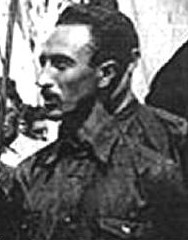
[Above: Salvador Abascal]
Further along these lines, according to one of Wertz’s online screeds,
“Nominally [the National Union of Synarchists] was founded by Salvador
Abascal, José Olivares, Manuel Zermeño, and Urquiza. In 1943, it had 500,000
members. However, the actual organizers were Hellmuth Oskar Schreiter
and the brothers José and Alfonso Trueba Olivares. The official papers listed
these three, plus Melchor Ortega and Adolfo Maldonado—Governor and
General Secretary of Guanajuato province—and I. G. Validvia, a Mexican
lawyer. Schreiter was a native of Germany and carried a German Nazi Party
card paid up to date on May 23, 1937. The Truevba [sic] Olivares brothers
were Spanish hacendados and leaders of the Falange Española.
This information on the National Union of Synarchists is fully confirmed in the
Oct. 31, 1941 report submitted by Harold P. Braman, Assistant U.S. Naval
Attaché in Mexico, who writes that the Trueba Olivares brothers first tried
to create a group called the ‘Sinarquistas’ in 1935 in Morelia, but the group
fared poorly. Only in 1937, when Schreiter entered the scene, did the Union
take off. Schreiter was a German engineer, who was a professor of English
in a school in Guanajuato. His wife was a relative of the Governor of the
state. In a report submitted on Feb. 2, 1944, Braman confirms that Schreiter
was a Nazi. ‘Oscar Hellmuth Schreiter and Otto Gilbert are principal Nazi
agents connected with Sinarquista organizations and have their
headquarters in Guanajuato.... A strong and dangerous Nazi affiliation with the
Sinarquistas was found throughout the State of Guanajuato. The principal
Germans connected with the movement, and who may be considered as
powerful figures behind the scenes, are Oscar Hellmuth Schreiter and Otto Gilbert.
‘It was also ascertained through a trusted informant, ... that every cent made
available to the Sinarquistas for the first year or so came direct from
Schreiter, who received it periodically from influential members of the German
colony in Mexico City. These latter are understood to have obtained the
funds direct from the German Legation in Mexico City.’
Braman also confirms the relationship between the Synarchists and the Church in
Mexico. ‘It so happens ... that the Church and the Falangists have a joint
council of strategy which, upon orders from Spain, pulls the Union's strings.
Orders to Spain come from Berlin.... [T]he Church of Mexico is at this
moment working in full cooperation with the Falangists whom they supported in
the Spanish Civil War. The Falangists want an all-powerful Spanish world
working alongside Germany, and Mexico is viewed by them as fertile ground
for a change-over in government which will bring the nation under direct
control of the Spain of today, like the days of the Spain of old.’”
(See http://www.larouchepub.com/other/2003/3029cristero.html wherein Wertz claims that the “Nazis used the Falange to create a Synarchist fifth column in Mexico.”)
The bloodbath that occurred in Mexico against the established Catholic order at the behest of Freemasons and their allies is not something most World War II history buffs know about. Apparently this area of research is one that individuals like William F Wertz, Jr of Executive Intelligence Review (EIR) wish to obfuscate. Wertz, like his idol LaRouche (a liberal Trotskyite), blames mostly “Nazis” and “fascists” for Mexico’s longstanding suffering (even today) as well as all the suffering that ensued during World War II. It was not liberal-democratic puppets and their Masonic masters pitting ‘free world armies’ against ‘warmongering fascist hordes’, oh no. It was the mindless ‘fascist hordes’ who had decided for no good reason at all to wage war on the entire ‘free world’, apparently to enslave it under ‘Nazi’ tutelage. The Falangists and Synarchists were just a bunch of “Nazi-Communist” flunkies (because the two are one and the same in Wertz’s opinion) riding on the coattails of Nazidom’s war against the world. Such a thesis would be laughable if so many people did not take it seriously. These are the folks who need to read the books that ignore the whistles and bells veiling the history of Freemasonry and Zionism.
I could talk World War Two with you all day long Veronica! It's been great talking with you about such an interesting and complex subject. Before we end this though, I'd like to bring up the book you are currently working on. Like all of your books, this one sounds very interesting; the treatment of black people in National Socialist Germany. Can you tell us more about it?
Indeed I can. My latest Wehrwolf book, Warwolves of the Iron Cross: Black Wolf, White Reich: An Afro-German Family in Nazi Germany, is my own translation of Preußisches Liebesglück (Prussian Bliss of Love) This is the true story of Gustav Sabac el Cher, a black man who lived in Königsberg, and was “the only black bandmaster of the German Army.”
The book takes the reader back in time, over 150 years ago. We meet the controversial Prussian Prince Albrecht and learn about him through his many adventures traveling and at war. Albrecht brought many things from his travels in Arabia. And one of those “things” was a gift from the Egyptian Viceroy Muhammad Ali: a seven-year-old dark-skinned boy. He was given the name August Albrecht Sabac el Cher and accompanied the Prince from that point on for several decades. The young black man eventually received professional career training as a servant at court in return for his previous services.
The climate in the Prussian state of the 40s and 50s was that of curiosity towards “others” as opposed to hostility. And so August’s dark skin was more of a positive than a negative. His career actually benefited from it. In 1867 he married the German, Anna Maria Jung, the daughter of a Berlin clothes maker. However, their two children, Gustav and Elise, were dealt a different fate. Son Gustav made his career as a conductor and raised a family. Daughter Elise, pregnant out of wedlock at a young age, remained unmarried. And while her daughter Gertrud also had children too early, she was able to find a faithful and successful husband. Elise’s granddaughter, Editha Horn, was successful as an actress during the Nazi period and afterwards.
Utilizing photos, records and witness accounts, the book paints a comprehensive picture of the family. Since the amount of material from the 19th century is thin, the beginning of the book is a bit slow-going, but afterwards the fate of the interesting family moves the reader right along. Thanks to diary entries and letters, the book also describes the relationships of the family members with one another. One learns that the sons of Gustav, Herbert and Horst, were very loved by the family. Both began to make music early on and both pursued professional careers. While Herbert continued in this vein with measurable success, Horst was not so lucky. In 1943 he was drafted as a medic by the Wehrmacht.
The Second World War and the West German vs. East German division tore the family apart. Horst’s wife and children (and children’s children by Elise) remained on the territory of the GDR, while Herbert lived with his family in the West.
Featuring the stories of over five generations, the reader feels that he/she is part of the Sabac el Cher family. Elise’s granddaughters, Editha and Ilse, remained unmarried and childless and the children of Gustav had few descendants. Horst died childless, though Herbert’s son Axel had a daughter (born in 1965) – but it appears she has no children.
Thus what begins as a search into the origins of the subject of a painting end in a family reunion.
Many thanks for your time and thoughts! Any final words of wisdom?
The only wisdom I have to offer my readers at this point is this: never become dogmatists unless you want to believe in something so strongly that you are willing to lie to yourself and others to defend that belief. I have found that too many revisionists and Hitler/NS admirers find themselves unable to fault either, and in so doing they compromise their honesty and scholarly integrity. If Hitler made a mistake or believed something that readers do not agree with, point it out. If readers feel that National Socialism had faults, name them and counteract them. No one is going to advance any cause by lying about it or presenting it as a perfect rose in a field of rotting weeds. All systems, movements and historical persons have their faults and foibles, so no serious revisionist or student of World War II history should be expected to ignore the faults and foibles of fascism, National Socialism or Hitler.
I would like to wrap up with a germane excerpt from my upcoming title, Black Wolf, White Reich, Vol. II:
Tina Campt, in “Reading the Black German Experience: An Introduction,”
explains how blackness in Germany includes Indians, Arabs and Asians (the
“Schwarze Deutsche”). In other words, blackness is not restricted to skin color or
race in the German schemata. This definition of blackness is important to
my thesis as well as the Black Nazis title. Numerous forum posters (on Axis
History Forum for example) and Amazon.com reviewers repeatedly fail to
understand this Germanic concept of blackness upon seeing the book title
Black Nazis. They imagine that the book is solely about African (“negroid”)
blacks and proceed to poke fun at the title and thesis as a result (usually
without having read the book). All sorts of convoluted visions of a “rainbow
Reich” and “Hitler as diversity advocate” swim around in their demented
heads when in fact my thesis has nothing to do with either of these
absurdities. It is frustrating, as I have explained more than once (and effectively
if I might say so myself) that the title Black Nazis is taken directly from
American wartime propaganda against Germany and the blacks that were
collaborating with ‘Nazidom’. The article in question is from the March 1939
edition of Ken, which I was able to acquire.
When I offered this as an explanation of the title I chose, the folks that swarm
the Axis History Forum day and night proceeded to unleash a barrage of
abuse upon me as well as upon my thesis. These Wehrmacht-worshippers
do not know me personally nor have any of them (save two) even read
Black Nazis. Yet the lot of them screamed “Holocaust denier” and shrieked “Nazi
apologist” without any evidence – aside from Internet rumor and hearsay
babble – thinking they were going to intimidate me and run me off their
little online empire. But that did not happen. Some of these forum boys
even cited fake quotes attributed to me back in 2007 by some blogger, who
I do not know. But I did not write or say the following quote:
“Jews are subhuman [expletive removed].
There. I said it because no one else has the gonads. Would I ever call for a
genocide against Jews? Well, if I was President of Los Estados
Unidos, then, ‘Yes, I would.’ I would bomb the living [expletive removed]
out of Tel Aviv and cut off all funding to all Jews. I would string up
their circus leaders-Chertoffsky would dangle from a rope. So would
Bush, Levy, Feinstein, Feingold, Boxer, Schumer, Lieberman, Clinton,
and all the other Jewish and crypto-Jewish rat-bags in the
Jewmerican government.”
Apparently this same blogger has since told some ‘white supremacist’ that I ran/run a blog at the following URL: http://nether-world.blogspot.com. But this has never been my blog. Incidentally, all of the links this blogger cites are defunct. What a surprise. Next thing I know he’ll be claiming that I wrote that the ‘Nazis’ ought to have gassed all the Jews in Palestine with their “Sun Gun” prototype in 1945!
This silliness aside, I stood my ground on AHF and decided then and there that I was going to provide the full text of this forum conversation as well as a comprehensive introduction addressing the criticisms therein in my sixth Wehrwolf book in the series, Black Wolf, White Reich, Volume II.
I wrote the first five Wehrwolf books from a more or less ‘pro-Nazi’ perspective to get my readership to critically assess and think about what they are told about World War II, its origins and its implications. We all know that the Allies won the war and most of us can agree that world history is consequently pro-Allied. My duty as an historian committed to a balanced point of view was to countermand this pro-Allied bias. This does not mean I ignored or omitted ‘Nazi’ crimes. I did neither. I just challenged the implicit Anglocentrism of the World War II narrative. In the minds of many there was a holocaust and in my view people have the right to assert this. While the number of Jewish sufferers and their manner of death remain debatable, the discrimination, uprooting and suffering that an untold number of Jewish people encountered is not. That was a crime against humanity regardless of what perspective one assumes. But the same must be said of the millions of uprooted Poles and the estimated 2-3 million Slavic soldiers who perished in German POW facilities. Whether they perished as a result of neglect, lack of supplies, exposure or starvation is irrelevant; their deaths were a war crime akin to the deaths of millions of German civilians and POWs held in Allied facilities after the war.
What I have not accepted and will not accept is that any one group’s suffering is either unique or worse than that of any other group in world history. To entertain such a notion is preposterous and I expand on this point in my forum answers later on in my next book.
I portray World War II from the vanquished perspective so that my readers understand that nothing we are told is “the truth.” There is no such thing as truth. There is only perception.
End notes:
¹ Per Wikipedia, “The Qianlong Emperor…ordered the genocide of the Zunghars, moving the remaining Dzungar people to the mainland and ordering the generals to kill all the men in Barkol or Suzhou, and divided their wives and children to Qing forces, which were made out of Manchu Bannermen and Khalkha Mongols. Qing scholar Wei Yuan estimated the total population of Dzungars before the fall at 600,000 people, or 200,000 households… In a widely cited account of the war, Wei Yuan wrote that about 40% of the Dzungar households were killed by smallpox, 20% fled to Russia or Kazakh tribes, and 30% were killed by the Qing army of Manchu Bannermen and Khalkha Mongols,… Based on this account, Wen-Djang Chu wrote that 80% of the 600,000 or more Dzungars (especially Choros, Olot, Khoid, Baatud and Zakhchin) were destroyed by disease and attack which Michael Clarke described as ‘the complete destruction of not only the Dzungar state but of the Zungars as a people.’ Historian Peter Perdue attributed the decimation of the Dzungars to an explicit policy of extermination launched by Qianlong, but he also observed signs of a more lenient policy after mid-1757. Mark Levene, a historian whose recent research interests focus on genocide, has stated that the extermination of the Dzungars was ‘arguably the eighteenth century genocide par excellence.’ It was not until generations later that Dzungaria rebounded from the destruction and near liquidation of the Zunghars after the mass slayings of nearly a million Zunghars….
The Qing ‘final solution’ of genocide to solve the problem of the Zunghar Mongols, made the Manchu Qing sponsored settlement of millions of Han Chinese, Hui, Turkestani Oasis people (Uyghurs) and Manchu Bannermen in Dzungaria possible, since the land was now devoid of Zunghars. The Dzungarian basin, which used to be inhabited by (Zunghar) Mongols, is currently inhabited by Kazakhs. The Dzungar (Zunghar) genocide has been compared to the Qing extermination of the Jinchuan Tibetan people in 1776.” (See http://en.wikipedia.org/wiki/Dzungar_Khanate)
Learn how to contact Veronica Clark and purchase her books
- HERE -
Back to Interviews
































